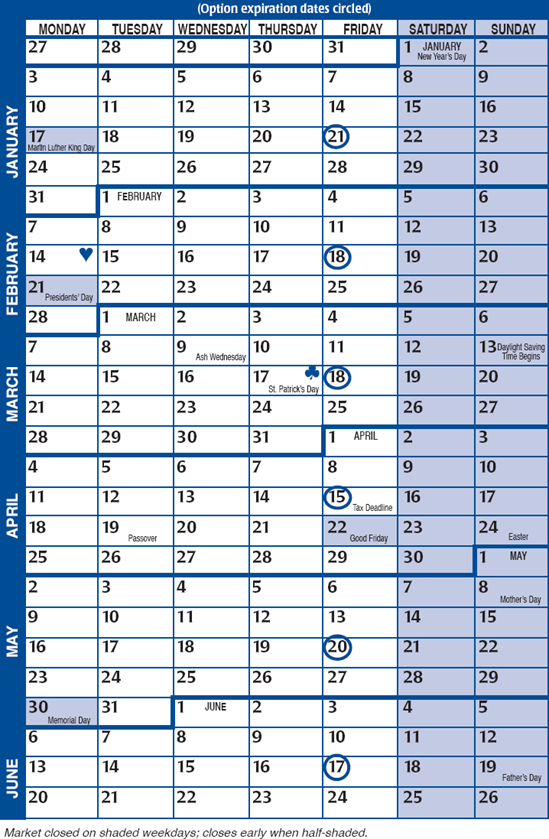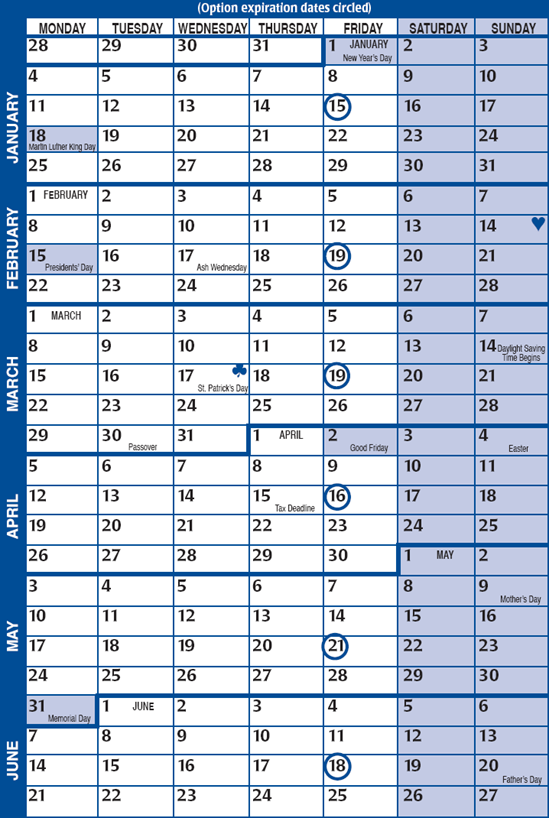
Market closed on shaded weekdays; closes early when half-shaded.
2010 STRATEGY CALENDAR
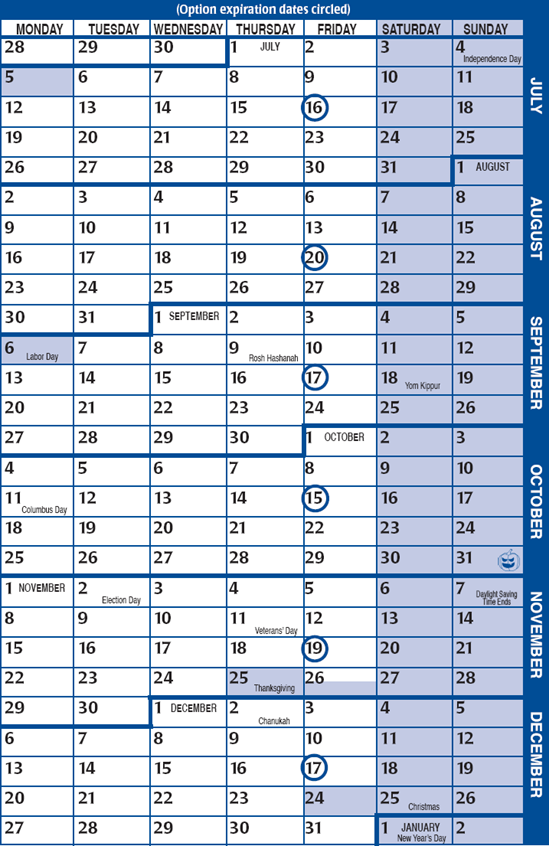
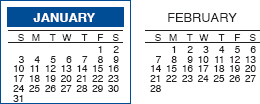
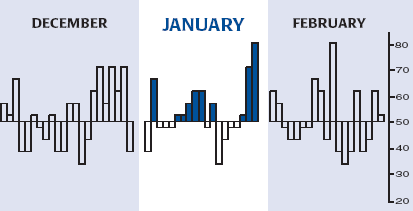
Market Probability Chart above is a graphic representation of the S&P 500 Recent Market Probability Calendar on page 124.
♦ January Barometer predicts year's course with .746 batting average (page 16) ♦ 10 of last 15 midterm election years followed January's direction ♦ Every down January on the S&P since 1950, without exception, preceded a new or extended bear market, a flat market, or a 10% correction (page 42) ♦ S&P gains January's first five days preceded full-year gains 86.1% of the time; of last 8 midterm years, only 2006 followed first five day's direction (page 14) ♦ November, December, and January constitute the year's best three-month span, a 4.2% S&P gain (pages 44 and 147) ♦ January NASDAQ powerful 3.0% since 1971 (pages 54 & 148) ♦ "January Effect" now starts in mid-December and favors small-cap stocks (pages 104 & 106) ♦ 2009 has the dubious honor of the worst S&P 500 January on record.
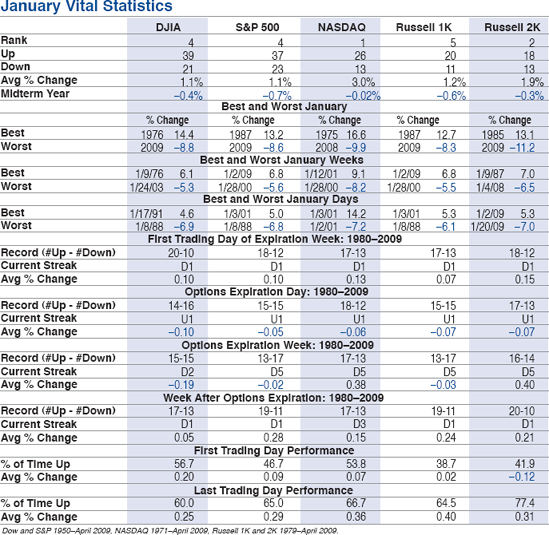
20th Amendment made "lame ducks" disappear. Now, "As January goes, so goes the odd-numbered year."
DECEMBER/JANUARY 2010

Ignorance is not knowing something; stupidity is not admitting your ignorance.

War is God's way of teaching Americans geography.

People become attached to their burdens sometimes more than the burdens are attached to them.
Last Trading Day of the Year; 2008 Broke 8-Year NASDAQ Losing Streak NASDAQ Was Up 29 Years in a Row 1971–1999

If you are ready to give up everything else—to study the whole history and background of the market and all the principal companies... as carefully as a medical student studies anatomy— ... and, in addition, you have the cool nerves of a great gambler, the sixth sense of a clairvoyant, and the courage of a lion, you have a ghost of a chance.
New Year's Day (Market Closed)

The symbol of all relationships among such men, the moral symbol of respect for human beings, is the trader.

January Almanac Investor Seasonalities: See Pages 114 and 116

The last 36 up First Five Days were followed by full-year gains 31 times, for an 86.1% accuracy ratio and a 13.7% average gain in all 36 years. The five exceptions include flat 1994 and four related to war. Vietnam military spending delayed start of 1966 bear market. Ceasefire imminence early in 1973 raised stocks temporarily. Saddam Hussein turned 1990 into a bear. The war on terrorism, instability in the Mideast, and corporate malfeasance shaped 2002 into one of the worst years on record. The 23 down First Five Days were followed by 12 up years and 11 down (47.8% accurate).
In midterm election years this indicator has had a spotty record—almost a contrary indicator. In the last 15 midterm years only seven full years followed the direction of the First Five Days and only one of the last eight (2006). The full-month January Barometer (page 16) has a better midterm record of 66.7% accurate.
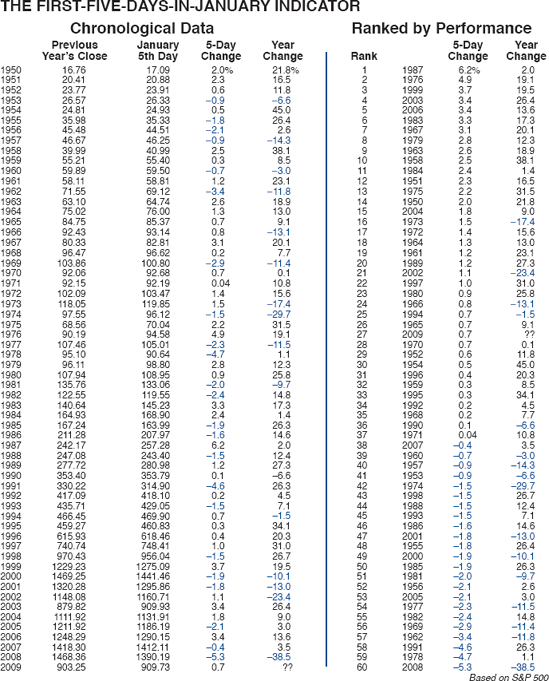
JANUARY
2009 Was the Best First Trading Day of the Year Since 2003 Dow Up 2.9%, S&P Up 3.2% and NASDAQ Up 3.5%

Cooperation is essential to address 21st-century challenges; you can't fire cruise missiles at the global financial crisis. — Nicholas D. Kristof (NY Times columnist, 10/23/2008, b. 1959)
Second Trading Day of the Year, Dow Up 12 of Last 16

Great spirits have always encountered violent opposition from mediocre minds.

All there is to investing is picking good stocks at good times and staying with them as long as they remain good companies.
January's First Five Days Act as an "Early Warning" (Page 14)

Let me tell you the secret that has led me to my goal. My strength lies solely in my tenacity.

One determined person can make a significant difference; a small group of determined people can change the course of history.


Devised by Yale Hirsch in 1972, our January Barometer states that as the S&P goes in January, so goes the year. The indicator has registered only five major errors since 1950 for a 91.5% accuracy ratio. Vietnam affected 1966 and 1968; 1982 saw the start of a major bull market in August; two January rate cuts and 9/11 affected 2001; and the anticipation of military action in Iraq held down the market in January 2003. (Almanac Investor newsletter subscribers were warned at the time not to heed the January Barometer's negative reading, as it was being influenced by Iraqi concerns.)
Including the 10 flat years (less than +/− 5%) yields a 74.6% accuracy ratio. A full comparison of all monthly barometers for the Dow, S&P and NASDAQ in our newsletter archives (March 2009) at www.stocktradersalmanac.com details January's market forecasting prowess. Bear markets began or continued when January's suffered a loss (see page 42). Full years followed January's direction in 10 of the last 15 Midterm election years. Three of the five errors (1970, 1978, and 1994) were flat; the other two were 1966 (Vietnam) and 1982 (new bull). See pages 18, 20, and 24 for more January Barometer items.
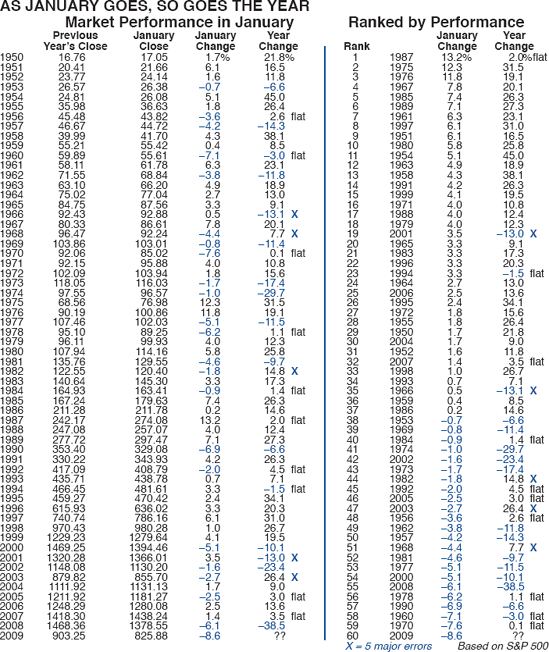
JANUARY
First Trading Day of January Expiration Week, Dow Up 9 of Last 13 Brutal in 2009, Dow −1.5%, S&P −2.3%, and NASDAQ −2.1%

There are very few instances in history when any government has ever paid off debt.

Benjamin Graham was correct in suggesting that while the stock market in the short run may be a voting mechanism, in the long run it is a weighing mechanism. True value will win out in the end.
January Expiration Week Horrible Since 1999, Dow Down Big 8 of Last 11

The knowledge of past times... is both an ornament and nutriment to the human mind.

The whole secret to our success is being able to con ourselves into believing that we're going to change the world [even though] we are unlikely to do it.
January Expiration Day, Dow Down 9 of Last 11 with Big Losses Off 2.0% in 2006, 1.3% in 2003, and 1.6% in 1999

Experience is helpful, but it is judgment that matters.



JANUARY
Martin Luther King Jr. Day (Market Closed)

In the end, we will remember not the words of our enemies, but the silence of our friends.

Those companies that the market expects will have the best futures, as measured by the price/earnings ratios they are accorded, have consistently done worst subsequently.
January Ends "Best Three-Month Span" (Pages 44, 54,147, and 148)

The market can stay irrational longer than you can stay solvent.

It is a funny thing about life; if you refuse to accept anything but the best, you very often get it.

If you want to raise a crop for one year, plant corn. If you want to raise a crop for decades, plant trees. If you want to raise a crop for centuries, raise men. If you want to plant a crop for eternities, raise democracies.


The S&P 500 in January tends to predict the market's direction for the year. In turn, Standard & Poor's top 10 industries in January outperform the index over the next 11 months.
Our friend Sam Stovall, chief investment strategist at S&P, has crunched the numbers over the years. He calls it the "January Barometer Portfolio," or JBP. Since 1970, a portfolio of the top 10 S&P industries during January has beaten the S&P 500 itself—and performed even better in years when January was up.
The JBP went on to outperform the S&P 500 during the remaining 11 months of the year 72% of the time, 14.2% to 5.8%, on average. When the S&P 500 is up in January, a top-10 industries portfolio increases the average portfolio gain to 19.4% for the last 11 months of the year vs. 12.2% for the S&P.
For more, check Sam's Sector Watch at businessweek.com or our March 2009 Almanac Investor newsletter in the archives at www.stocktradersalmanac.com. Also highlighted are Sam's selected stocks from within the top 10 industries, as well as the top three sectors and related ETFs.

JANUARY

Mankind is divided into three classes: Those that are immovable, those that are movable, and those that move.

History must repeat itself because we pay such little attention to it the first time.
FOMC Meeting (2 Days)

While one person hesitates because he feels inferior, the other is busy making mistakes and becoming superior.

You get stepped on, passed over, knocked down, but you have to come back.
"January Barometer" 91.5% Accurate (Page 16) Almanac Investor Subscribers E-mailed Official Reading Alert

Life is like riding a bicycle. You don't fall off unless you stop peddling.

February Almanac Investor Seasonalities: See Pages 114 and 116



Market Probability Chart above is a graphic representation of the S&P 500 Recent Market Probability Calendar on page 124.
♦ February is the weak link in "Best Six Months" (pages 44, 48, and 147) ♦ RECENT RECORD deteriorating: S&P up 3, down 8, average change −2.9% last 11 years ♦ Fifth-ranking NASDAQ month in midterm election years average 0.2%, up 4 down 5 (page 157), #6 Dow, up 10 down 5 and #6 S&P (pages 153 and 155), up 8, down 7 ♦ Day before Presidents' Day weekend, S&P down 15 of 18, 11 straight 1992–2002, day after dicey, up 9 of 18 (see pages 84 and 133) ♦ Many technicians modify market predictions based on January's market.
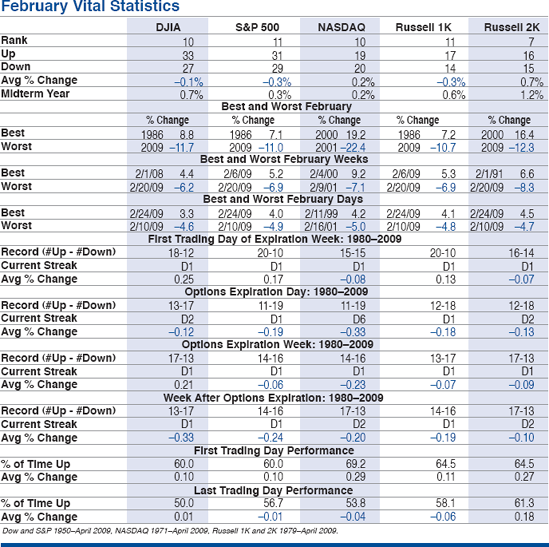
Either go short, or stay away the day before Presidents' Day.
FEBRUARY
First Day Trading in February, 2009 Broke 6-Year Dow and S&P Winning Streak NASDAQ's 5-Year Win Streak Remains Intact

Real knowledge is to know the extent of one's ignorance.

A person's greatest virtue is his ability to correct his mistakes and continually make a new person of himself.

I am glad that I paid so little attention to good advice; had I abided by it I might have been saved from my most valuable mistakes.

In this game, the market has to keep pitching, but you don't have to swing. You can stand there with the bat on your shoulder for six months until you get a fat pitch.

Self-discipline is a form of freedom. Freedom from laziness and lethargy, freedom from expectations and demands of others, freedom from weakness and fear—and doubt.


There would be no January Barometer without the passage in 1933 of the Twentieth "lame duck" Amendment to the Constitution. Since then, it has essentially been, "As January goes, so goes the year." January's direction has correctly forecasted the major trend for the market in most of the subsequent years.
Prior to 1934, newly elected senators and representatives did not take office until December of the following year, 13 months later (except when new presidents were inaugurated). Defeated congressmen stayed in Congress for all of the following session. They were known as "lame ducks."
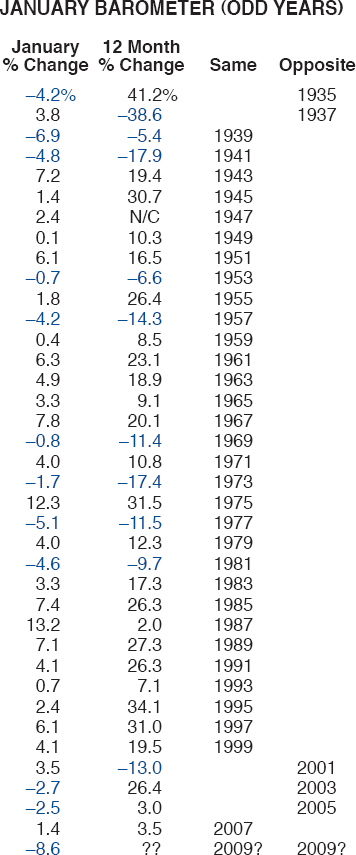
12 months % change includes Januarys % change. Based on S&P 500.
Since 1934, Congress convenes in the first week of January and includes those members newly elected the previous November. Inauguration Day was also moved up from March 4 to January 20. As a result, several events have been squeezed into January, which affect our economy and our stock market and quite possibly those of many nations of the world.
The basis for January's predictive capacity comes from the fact that so many important events occur in the month: New Congresses convene; the president gives the State of the Union message, presents the annual budget, and sets national goals and priorities. Switch these events to any other month and chances are, the January Barometer would become a memory.
The table shows the January Barometer in odd years. In 1935 and 1937, the Democrats already had the most lopsided Congressional margins in history, so when these two Congresses convened it was anticlimactic.
The January Barometer in subsequent odd-numbered years had compiled a perfect record until two January interest rate cuts and the 9/11 attack affected 2001, the anticipation of military action in Iraq held the market down in January 2003, and we experienced a flat 2005. 2007 marked the reemergence of odd-year January Barometer accuracy.
See the January Barometer compared to prior "New Congress Barometers" at www.stocktradersalmanac.com.
FEBRUARY

When everybody thinks alike, everyone is likely to be wrong.

The authority of a thousand is not worth the humble reasoning of a single individual.

Sight and sound function differently in the mind, with sound being the surer investment. WIN THE EARS OF THE PEOPLE, THEIR EYES WILL FOLLOW.

The thing always happens that you really believe in. The belief in a thing makes it happen.
Day Before Presidents' Day Weekend, S&P Down 15 of Last 18 Off 11 in a Row 1992–2002

Whenever you see a successful business, someone once made a courageous decision.


Valentine's Day
Tenth years have, on average, have been the worst years of the decade. There were four major wars and the Iran hostage crisis. Sizable declines (or bear markets) occurred in all. During the last nine decades, the market ended up on three occasions. Also a midterm election year, 2010 is vulnerable to declines. See pages 129–130 for further detail.
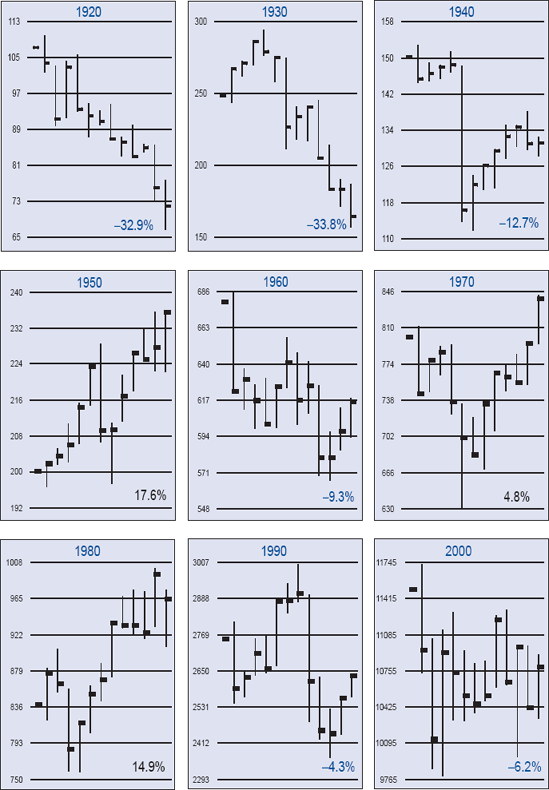
Based on Dow Jones Industrial Average monthly ranges and closing prices.
FEBRUARY
Presidents' Day (Market Closed)

At a time of war, we need you to work for peace. At a time of inequality, we need you to work for opportunity. At a time of so much cynicism and so much doubt, we need you to make us believe again.
Monday Before February Expiration Dow Down 4 of Last 5 2009 Dow Down 3.8%; Up 11 Straight 1994 to 2004

New Issues: The closest thing to a "sure thing" Wall Street has to offer.
Ash Wednesday

We will have to pay more and more attention to what the funds are doing. They are the ones who have been contributing to the activity, especially in the high-fliers.

The greatest lie ever told: Build a better mousetrap and the world will beat a path to your door.
February Expiration Day, Dow Down 7 of Last 10

Methodology is the last refuge of a sterile mind.



Based on Dow Jones Industrial Average monthly closing prices.
FEBRUARY

The average bottom-of-the-ladder person is potentially as creative as the top executive who sits in the big office. The problem is that the person on the bottom of the ladder doesn't trust his own brilliance and doesn't, therefore, believe in his own ideas.

In my experience, selling a put is much safer than buying a stock.
End of February Miserable in Recent Years (Page 133)

When a falling stock becomes a screaming buy because it cannot conceivably drop further, try to buy it 30 percent lower.

Cannot people realize how large an income is thrift?

Industrial capitalism has generated the greatest productive power in human history. To date, no other socioeconomic system has been able to generate comparable productive power.

March Almanac Investor Seasonalities: See Pages 114 and 116



Market Probability Chart above is a graphic representation of the S&P 500 Recent Market Probability Calendar on page 124.
♦ Mid-month strength and late-month weakness are most evident above ♦ RECENT RECORD: S&P 17 up, 9 down, average gain 1.2%, fourth best ♦ Rather turbulent in recent years with wild fluctuations and large gains and losses ♦ March has been taking some mean end-of-quarter hits (page 134), down 1,469 Dow points March 9–22, 2001 ♦ Last three or four days Dow a net loser 14 out of last 18 years ♦ NASDAQ hard hit in 2001, down 14.5% after 22.4% drop in February ♦ Third best NASDAQ month during midterm election years average gain 1.5%, up 6, down 3.
March Vital Statistics
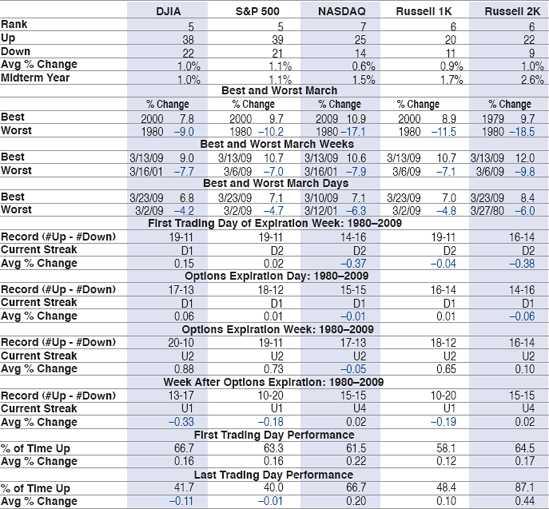
March has Ides and St. Patrick's Day; Begins bullishly, then fades away.
MARCH
First Trading Day in March, Dow Down 3 Straight, −4.2% in 2009, 1996–2006 Up 9 of 11

Things may come to those who wait, but only the things left by those who hustle.

The advice of the elders to young men is very apt to be as unreal as a list of the best books.
March Historically Strong Early in the Month

Unless you've interpreted changes before they've occurred, you'll be decimated trying to follow them.

Civility is not a sign of weakness, and sincerity is always subject to proof. Let us never negotiate out of fear. But let us never fear to negotiate.

There is no tool to change human nature...people are prone to recurring bouts of optimism and pessimism that manifest themselves from time to time in the buildup or cessation of speculative excesses.


American presidents have danced the Quadrennial Quadrille over the past two centuries. After the midterm congressional election and the invariable seat loss by his party, the president during the next two years jiggles fiscal policies to get federal spending, disposable income, and social security benefits up, and interest rates and inflation down. By Election Day, he will have danced his way into the wallets and hearts of the electorate and, hopefully, will have choreographed four more years in the White House for his party.
After the Inaugural Ball is over, however, we pay the piper. Practically all bear markets began and ended in the two years after presidential elections. Bottoms often occurred in an air of crisis: the Cuban Missile Crisis in 1962, tight money in 1966, Cambodia in 1970, Watergate and Nixon's resignation in 1974, and threat of international monetary collapse in 1982. But remember, the word for "crisis" in Chinese is composed of two characters: the first, the symbol for danger; the second, opportunity. In the last 12 quadrennial cycles since 1961, 9 of the 14 bear markets bottomed in the midterm year. See pages −132 for further detail.
THE RECORD SINCE 1914
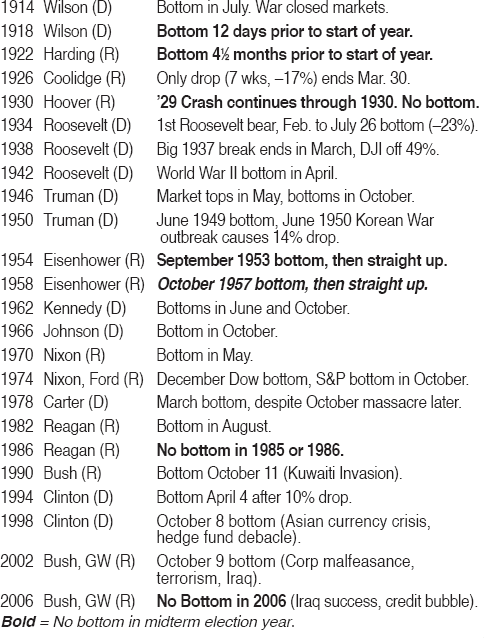

Graph shows midterm election years screened; Based on Dow Jones Industrial Average monthly ranges.
MARCH

You have powers you never dreamed of. You can do things you never thought you could do. There are no limitations in what you can do except the limitations in your own mind.
Dow Down 1469 Points March 9–22 in 2001

The market is a voting machine, whereon countless individuals register choices which are the product partly of reason and partly of emotion.

The heights by great men reached and kept, were not attained by sudden flight, but they, while their companions slept, were toiling upward in the night.

I'm a great believer in luck, and I find the harder I work the more I have of it.

If the models are telling you to sell, sell, sell, but only buyers are out there, don't be a jerk. Buy!

Daylight Saving Time Begins
Though the stock market in presidential election years very often is able to predict if the party in power will retain or lose the White House, the outcome of congressional races in midterm years is another matter entirely. Typically, the president's party will lose a number of House seats in these elections (1934, 1998, and 2002 were exceptions). It is considered a victory for the president when his party loses a small number of seats, and a repudiation of sorts when a large percentage of seats is lost.
The table below would seem to indicate that there is no relationship between the stock market's behavior in the 10 months prior to the midterm election and the magnitude of seats lost in the House. Roaring bull markets preceded the elections of 1954 and 1958, yet Republicans lost few seats during one, and a huge number in the other.
If the market does not offer a clue to the outcome of House races, does anything besides the popularity and performance of the administration? Yes! In the two years prior to the elections in the first 10 midterm years listed, no war or major recession began. As a result, the percentage of House seats lost was minimal. A further observation is that the market gained ground in the last seven weeks of the year, except 2002.
Our five major wars began under four Democrats and one Republican in the shaded area. The percentage of seats lost was greater during these midterm elections. But the seven worst repudiations of the president are at the bottom of the list. These were preceded by the sick economy in 1930, the botched health proposals in 1994, the severe recession in 1937, the postwar contraction in 1946, the recession in 1957, Watergate in 1974, and rumors of corruption (Teapot Dome) in 1922. Obviously, prosperity is of greater importance to the electorate than peace!
LAST 23 MIDTERM ELECTIONS RANKED BY % LOSS OF SEATS BY PRESIDENT'S PARTY
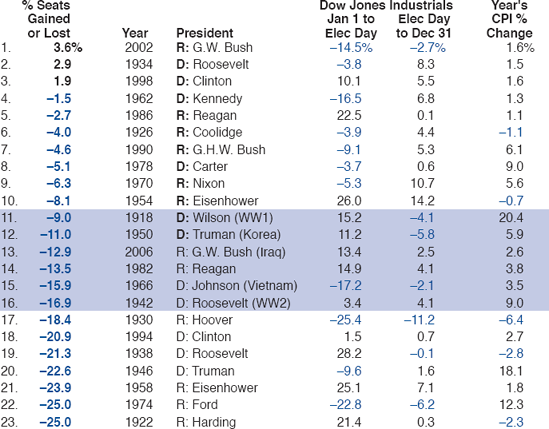
MARCH
Monday Before March Triple Witching, Dow Up 16 of Last 22

An economist is someone who sees something happen, and then wonders if it would work in theory.

The CROWD is always wrong at market turning points but often times right once a trend sets in. The reason many market fighters go broke is they believe the CROWD is always wrong. There is nothing further from the truth. Unless volatility is extremely low or very high one should think twice before betting against the CROWD.
St. Patrick's Day

Bull markets are born on pessimism, grow on skepticism, mature on optimism, and die on euphoria.

Age is a question of mind over matter. If you don't mind, it doesn't matter.
March Triple Witching Day 50–50 Last 10 Years Big Gains 2003, Up 2.8% and 2008, Up 2.2%

The only way to even begin to manage this new world is by focusing on... nation building — helping others restructure their economies and put in place decent non-corrupt government.


Eleven financial crises have affected Wall Street since 1900. These are not exogenous crises such as Pearl Harbor, Watergate, or 9/11, but strictly market-related events. Those that were dealt with effectively and expeditiously, or nonsystemic, were short and/or mild. The four crises from 1976–1978, 1978–1980, 1988–1990, and 1997–1998 had bear markets that were less severe. The other seven, including the 2007–2009 global financial crisis, had greater impact on the market as a whole and the damage was greater.
After the 1929 Crash, the Dow was cut by 89.2% and it took 25 years until a new high was reached. The 1901–1903 Rich Man's Panic created one of the 10 worst bears (see below), but the market recovered in less than four years. The Panic of 1907 and the 1973 Arab Oil Embargo held the market back for nearly 10 years. The OPEC Price Increase in 1976 helped keep a lid on stocks for 4.5 years. Stagflation and the Hunt Silver Corner help force a bottom in 1980, but the market bounced back in two years.
Iraq's August 2, 1990, invasion of Kuwait arguably had a greater effect on the market than the well-contained S&L Bailout as a new high was reached in less than a year, shortly after Kuwait was liberated. The 1997–1998 Asian/Russian currency crisis spawned the shortest bear market in history (45 days) and the market recovered in less than three months.
When the tech bubble popped in 2000, the market fell for nearly two years, slashing NASDAQ 77.9% from March 2000 to October 2002. It took almost seven years for the Dow to recover the 2000 high. NASDAQ has only recovered just over half at its recent high in October 2007.
HOW FINANCIAL CRISES SINCE 1900 IMPACTED THE MARKET

The current bear market has the dubious honor of being the second worst bear market since 1900. All 10 worst bears have suffered losses of 40% or more. Other than the 1973–1974 bear, all the previous instances occurred before the end of WWII and the bear that ran from 1939 to 1942, when the United States entered the war, is the only one to escape recession. Financial panic caused the first two, WWI affected the next two, the next three occurred during the Great Depression, WWII shaped the next, and with a little help from Watergate, the Oil Embargo fueled the last. We have included the dates of the accompanying recessions and subsequent bull market for further perspective.
Until the 2007–2009 decline, the only bear market to log a greater than 50% loss on the DJIA and S&P 500 was the 1929–1930 decline that begot the Great Depression. Another contraction of that magnitude and extent does not appear to be in the cards. The economy and market seem to be on the mend, but it would not be surprising if Dow 14000 was elusive for at least a couple of years.
TEN WORST BEAR MARKETS SINCE 1900

MARCH
March Historically Weak Later in the Month

The political problem of mankind is to combine three things: economic efficiency, social justice, and individual liberty.

I have learned as a composer chiefly through my mistakes and pursuits of false assumptions, not by my exposure to founts of wisdom and knowledge.
Week After Triple Witching, Dow Down 15 of Last 22, but Rallied 4.9% in 2000, 3.1% in 2007, and a Whopping 6.8% in 2009

Prosperity is a great teacher; adversity a greater.

Don't be overly concerned about your heirs. Usually, unearned funds do them more harm than good.

You must automate, emigrate, or evaporate.

April Almanac Investor Seasonalities: See Pages 114 and 116



Market Probability Chart above is a graphic representation of the S&P 500 Recent Market Probability Calendar on page 124.
♦ April is still the best Dow month (average 2.0%) since 1950 (page 44) ♦ April 1999 first month ever to gain 1000 Dow points, 856 in 2001, knocked off its high horse in 2002 down 458, 2003 up 488 ♦ Prone to weakness after mid-month tax deadline ♦ Stocks anticipate great first quarter earnings by rising sharply before earnings are reported, rather than after ♦ Rarely a dangerous month except in big bear markets (like 2002), took the brunt of first-half declines in 2004 and 2005 ♦ "Best Six Months" of the year end with April (page 48) ♦ Since 1974, midterm election year Aprils have been weaker (#4 Dow, #6 S&P, #7 NASDAQ) ♦ End of April NASDAQ strength (pages 125 and 126).

April "Best Month" for Dow since 1950; Day-before-Good Friday gains are nifty.
MARCH/APRIL
Start Looking for the Dow and S&P MACD SELL Signal (Pages 48 and 50) Almanac Investor Subscribers E-mailed Alert When It Triggers

Awareness of competition and ability to react to it is a fundamental competence every business must have if it is to be long lived.
Passover

The reading of all good books is indeed like a conversation with the noblest men of past centuries, in which they reveal to us the best of their thoughts.
Last Trading Day of March, Dow Down 10 of Last 15, But Up Last 3

A national debt, if it is not excessive, will be to us a national blessing.
First Trading Day in April, Dow Up 12 of Last 15, 2008 +3.2%, 2009 +2.0% NASDAQ Up 13 of 15 Day Before Good Friday, 9 Straight Since 2001

The most dangerous thing that takes place [in companies] is that success breeds arrogance, and arrogance seems to make people stop listening to their customers and to their employees. And that is the beginning of the end. The challenge is not to be a great company; the challenge is to remain a great company.
Good Friday (Market Closed)

There is no one who can replace America. Without American leadership, there is no leadership. That puts a tremendous burden on the American people to do something positive. You can't be tempted by the usual nationalism.

Easter

When the Dow closes below its December closing low in the first quarter, it is frequently an excellent warning sign. Jeffrey Saut, managing director of investment strategy at Raymond James, brought this to our attention a few years ago. The December Low Indicator was originated by Lucien Hooper, a Forbes columnist and Wall Street analyst back in the 1970s. Hooper dismissed the importance of January and January's first week as reliable indicators. He noted that the trend could be random or even manipulated during a holiday-shortened week. Instead, said Hooper, "Pay much more attention to the December low. If that low is violated during the first quarter of the New Year, watch out!"
Sixteen of the 30 occurrences were followed by gains for the rest of the year—and 14 full-year gains—after the low for the year was reached. For perspective we've included the January Barometer readings for the selected years. Hooper's "Watch Out" warning was absolutely correct, though. All but two of the instances since 1952 experienced further declines, as the Dow fell an additional 10.9% on average when December's low was breached in Q1.
Only three significant drops occurred (not shown) when December's low was not breached in Q1 (1974, 1981, and 1987). Both indicators were wrong only three times, and six years ended flat. If the December low is not crossed, turn to our January Barometer for guidance. It has been virtually perfect, right nearly 100% of these times (view the complete results at www.stocktradersalmanac.com).

APRIL
Day After Easter, Worst Post-Holiday, S&P Down 16 of 20 from 1984 to 2003, But Improving Recently, Up 5 of Last 6, Including 1.5% Gain in 2008

The monuments of wit survive the monuments of power.

The reason the market did so well in the last several years is because the Federal Reserve drove interest rates down to extraordinary low levels—like 1%.

A day will come when all nations on our continent will form a European brotherhood...
A day will come when we shall see... the United States of Europe...reaching out for each other across the seas.

The dissenter (or "contrary investor") is every human at those moments of his life when he resigns momentarily from the herd and thinks for himself.
April Is the Best Month for the Dow, Average 1.9% Gain Since 1950 3rd Best Month for S&P, 4th Best for NASDAQ (Since 1971)

There is only one side of the market and it is not the bull side or the bear side, but the right side.


In the first third of the twentieth century, there was no correlation between January markets and the year as a whole (page 24). Then, in 1972 we discovered that the 1933 "lame duck" Amendment to the Constitution changed the political calendar, and the January Barometer was born. Its record has been quite accurate (page 16).
Down Januarys are harbingers of trouble ahead, in the economic, political, or military arenas. Eisenhower's heart attack in 1955 cast doubt on whether he could run in 1956'a flat year. Two other election years with down Januarys were also flat (1984 and 1992). Twelve bear markets began and nine continued into second years with poor Januarys: 1968 started down as we were mired in Vietnam, but Johnson's "bombing halt" changed the climate. Imminent military action in Iraq held January 2003 down before the market triple-bottomed in March. After Baghdad fell, preelection and recovery forces fueled 2003 into a banner year. 2005 was flat, registering the narrowest Dow trading range on record. Strongly negative readings in 2008 and 2009 foreshadowed and confirmed, respectively, the current financial crisis that is only now beginning to show signs of abating.
Unfortunately, bull and bear markets do not start conveniently at the beginnings and ends of months or years. Though some years ended higher, every down January since 1950 was followed by a new or continuing bear market, a 10% correction or a flat year. Excluding 1956, down Januarys were followed by substantial declines averaging minus 14.1%, providing excellent buying opportunities later in most years.

APRIL
Monday Before Expiration, Dow Down 4 of Last 5

You try to be greedy when others are fearful, and fearful when others are greedy.

Today we deal with 65,000 more pieces of information each day than did our ancestors 100 years ago.

The universal line of distinction between the strong and the weak is that one persists, while the other hesitates, falters, trifles and at last collapses or caves in.
Income Tax Deadline
Generally Bullish, Dow Down Only Five Times Since 1981

I cannot give you a formula for success but I can give you a formula for failure: Try to please everybody.
April Expiration Day Dow Up 11 of Last 13, 2007 Up 1.2%, 2008 Up 1.8%

If you don't keep [your employees] happy, they're not going to keep the [customers] happy.


Monthly performance of the S&P and the Dow are ranked over the past 591/3 years. NASDAQ monthly performance is shown on page 54.
January, April, November, and December still hold the top four positions in both the Dow and S&P; March has reclaimed the fifth spot on the Dow. This led to our discovery in 1986 of the market's best-kept secret. You can divide the year into two sections and have practically all the gains in one six-month section and very little in the other. September has been the worst month on both lists. (See "Best Six Months" on page 48.)

Anticipators, shifts in cultural behavior, and faster information flow have altered seasonality in recent years. Here is how the months ranked over the past 151/3 years (184 months) using total percentage gains on the S&P 500: April 38.3, November 22.7, December 18.3, March 18.0, October 17.9, May 16.6, January 2.7, June −1.6, July −7.4, August −9.5, September −11.8, February −22.9.
During the last 151/3 years, front-runners of our Best Six Months may have helped push October into the number-five spot. May has leapfrogged into the number-six spot. January has declined in 6 of the last 10 years. Sizable turnarounds in "bear killing" October were a common occurrence from 1998 to 2007. Recent big Dow losses in the period were: August 1998 (SE Asia crisis), off 15.1%; September 2001 (9/11 attack), off 11.1%; September 2002 (Iraq war drums), off 12.4%; October 2008, off 14.1% and February 2009 (financial crisis), off 11.7%.
APRIL

I never buy at the bottom and I always sell too soon.

When America sneezes, the rest of the word catches cold.
April Prone to Weakness After Tax Deadline

You have to keep digging, keep asking questions, because otherwise you'll be seduced or brainwashed into the idea that it's somehow a great privilege, an honor, to report the lies they've been feeding you.

I have always picked people's brains. That's the only way you can grow; 90 percent of the information I throw out immediately; 5 percent I try and discard; and 5 percent I retain.

A good manager is a man who isn't worried about his own career but rather the careers of those who work for him... Don't worry about yourself! Take care of those who work for you and you'll float to greatness on their achievements.




Market Probability Chart above is a graphic representation of the S&P 500 Recent Market Probability Calendar on page 124.
♦ "May/June disaster area" between 1965 and 1984 with S&P down 15 out of 20 Mays ♦ Between 1985 and 1997 May was the best month, with 13 straight gains, gaining 3.3% per year on average, up 6, down 5 since ♦ Worst six months of the year begin with May (page 48) ♦ A $10,000 investment compounded to $464,305 for November to April in 59 years compared to a $1,988 loss for May to October ♦ Dow Memorial Day week record: up 12 years in a row (1984–1995), down seven of the last 13 years ♦ Since 1974, midterm election year NASDAQ Mays rank eighth with an average 0.9% loss.
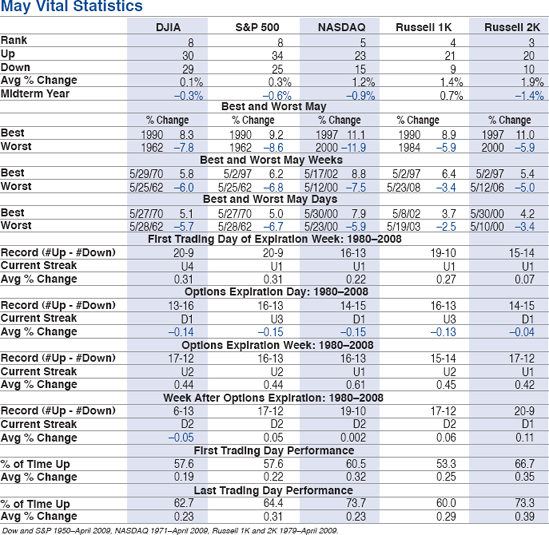
Was Number One month for nine straight years; But five out of the last ten have caused May tears.
APRIL/MAY
April 1999 First Month Ever to Gain 1000 Dow Points

Institutions tend to dump stock in a single transaction and buy, if possible, in smaller lots, gradually accumulating a position. Therefore, many more big blocks are traded on downticks than on upticks.

There's nothing wrong with cash. It gives you time to think.

We are handicapped by policies based on old myths rather than current realities.
End of "Best Six Months" of the Year (Pages 44, 48, 50, and 147)

If you destroy a free market you create a black market. If you have ten thousand regulations, you destroy all respect for the law.

Love your enemies, for they tell you your faults.

May Almanac Investor Seasonalities: See Pages 114 and 116

Our Best Six Months Switching Strategy consistently delivers. Investing in the Dow Jones Industrial Average between November 1st and April 30th each year and then switching into fixed income for the other six months has produced reliable returns with reduced risk since 1950.
The chart on page 147 shows November, December, January, March, and April to be the top months since 1950. Add February, and an excellent strategy is born! These six consecutive months gained 10407.20 Dow points in 59 years, while the remaining May through October months lost 2453.41 points. The S&P gained 1002.09 points in the same best six months versus a loss of 147.35 points in the worst six.
Percentage changes are shown, along with a compounding $10,000 investment. The November-April $464,305 gain overshadows May-October's $1,988 loss. (S&P results were $336,187 to $3,979.) Just three November-April losses were double-digit: April 1970 (Cambodian invasion), 1973 (OPEC oil embargo), and 2008 (financial crisis). Similarly, Iraq muted the Best Six and inflated the Worst Six in 2003. When we discovered this strategy in 1986, November-April outperformed May-October by $88,163 to minus $1,522. Results improved substantially these past 23 years, $354,742 to minus $915. A simple timing indicator triples results (page 50).
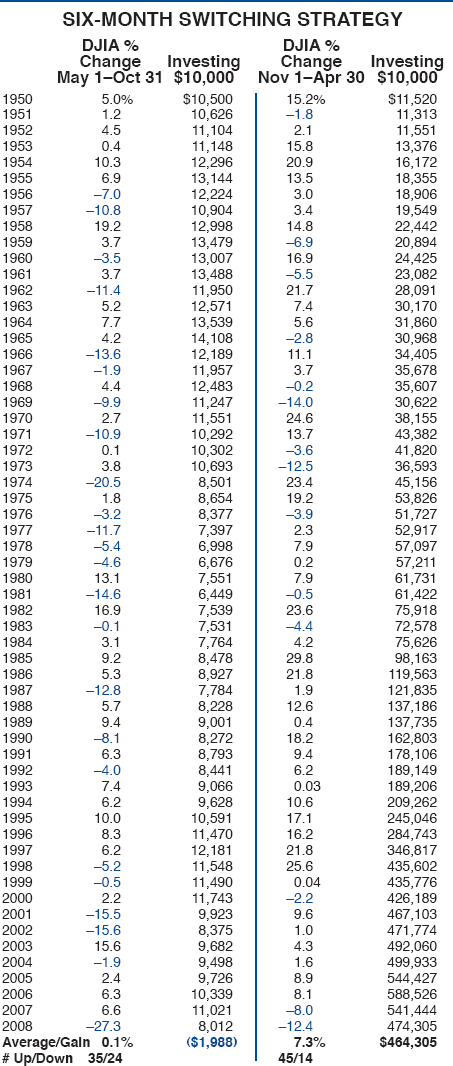
MAY
First Trading Day in May, Dow Up 9 of Last 11

If the market does not rally, as it should during bullish seasonal periods, it is a sign that other forces are stronger and that when the seasonal period ends those forces will really have their say.

The stock market is that creation of man which humbles him the most.

Change is the law of life. And those who look only to the past or present are certain to miss the future.

When I talk to a company that tells me the last analyst showed up three years ago, I can hardly contain my enthusiasm.
Friday Before Mother's Day, Dow Up 9 of Last 14

To change one's life: Start immediately. Do it flamboyantly. No exceptions.

Mother's Day

Using the simple MACD (Moving Average Convergence Divergence) indicator developed by our friend Gerald Appel to better time entries and exits into and out of the Best Six Months (page 48) period nearly triples the results. Several years ago, Sy Harding enhanced our Best Six Months Switching Strategy with MACD triggers, dubbing it the "best mechanical system ever." In 2006, we improved it even more, quadrupling the results with just four trades every four years (page 60).
Our Almanac Investor News-letter and Platform implements this system with quite a degree of success. Starting October 1, we look to catch the market's first hint of an uptrend after the summer doldrums, and beginning April 1 we prepare to exit these seasonal positions as soon as the market falters.
In up-trending markets, MACD signals get you in earlier and keep you in longer. But if the market is trending down, entries are delayed until the market turns up and exit points can come a month earlier. Thus, our "Best Six Months" could be lengthened or shortened a month or so.
The results are astounding applying the simple MACD signals. Instead of $10,000 gaining $464,305 over the 59 recent years when invested only during the Best Six Months (page 48), the gain nearly tripled to $1,328,258. The $1,988 loss during the worst six months expanded to a loss of $7,207.
Impressive results for being invested during only 6.4 months of the year on average! For the rest of the year, you could park in a money market fund, purchase index puts or bear funds, or if a long-term holder, you could write options on your positions (sell call options).
Updated signals are e-mailed to our monthly newsletter subscribers as soon as they are triggered. For further information on how the MACD indicator is calculated, dates when signals were given, visit www.stocktradersalmanac.com.
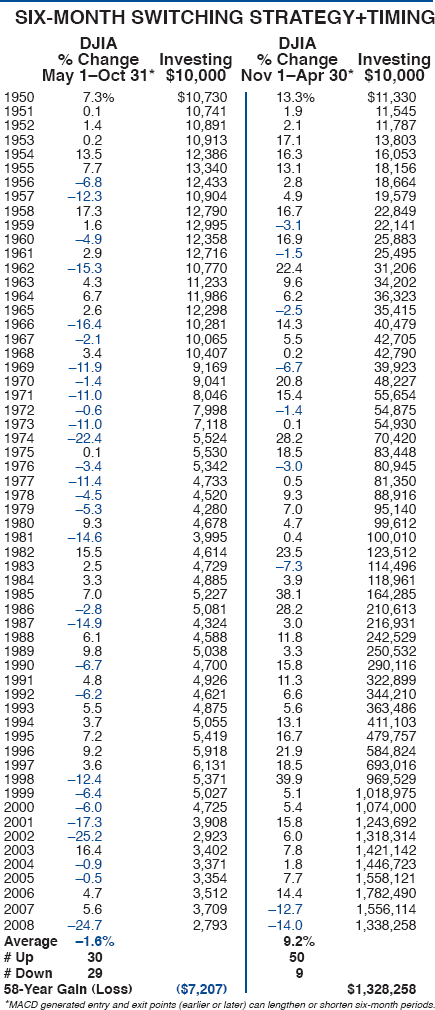
MAY
Monday After Mother's Day, Dow Up 12 of Last 14

Most people have no idea of the giant capacity we can immediately command when we focus all of our resources on mastering a single area of our lives.

The fear of capitalism has compelled socialism to widen freedom, and the fear of socialism has compelled capitalism to increase equality.

If I had my life to live over again, I would elect to be a trader of goods rather than a student of science. I think barter is a noble thing.

If you create an act, you create a habit. If you create a habit, you create a character. If you create a character, you create a destiny.

New indicator: CFO Magazine gave Excellence awards to WorldCom's Scott Sullivan (1998), Enron's Andrew Fastow (1999), and to Tyco's Mark Swartz (2000). All were subsequently indicted.


For market professionals and serious traders, Fridays and Mondays are the most important days of the week. Friday is the day for squaring positions—trimming longs or covering shorts before taking off for the weekend. Pros want to limit their exposure (particularly to stocks that are not acting well) since there could be unfavorable developments before trading resumes two or more days later.
Monday is important because the market then has the chance to reflect any weekend news, plus what traders think after digesting the previous week's action and the many Monday morning research and strategy comments.
We've been watching Friday to Monday market behavior for over 30 years. In this time we have observed that a down Friday followed by down Monday is often an important market inflection point that exhibits a clearly negative bias and frequently coincides with market tops, and on a few climactic occasions, such as in October 2002, near major market bottoms.

One simple way to get a quick reading on which way the market may be heading is to keep track of the performance of the Dow Jones Industrial Average on Fridays and the following Mondays. Since 1995, there have been 151 occurrences of Down Friday/Down Monday (DF/DM), with 52 falling in the bear market years of 2001, 2002, 2008, and 2009, producing an average decline of 13.7%.
To illustrate how Down Friday/Down Monday can telegraph market infection points, we created the chart below of the Dow Jones Industrials from November 2007 to May 1, 2009, with arrows pointing to occurrences of DF/DM. Use DF/DM as a warning to examine market conditions carefully.
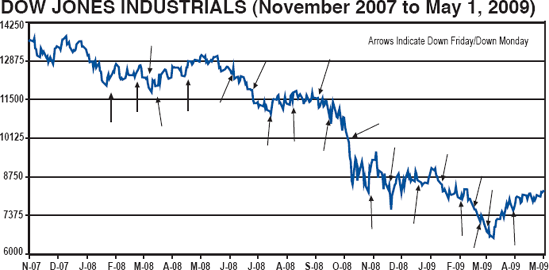
MAY
Monday Before May Expiration, Dow Up 19 of Last 21

The less a man knows about the past and the present, the more insecure must be his judgment of the future.

Whatever method you use to pick stocks..., your ultimate success or failure will depend on your ability to ignore the worries of the world long enough to allow your investments to succeed. It isn't the head but the stomach that determines the fate of the stockpicker.

We do not believe any group of men adequate enough or wise enough to operate without scrutiny or without criticism... the only way to avoid error is to detect it, that the only way to detect it is to be free to inquire... in secrecy error undetected will flourish and subvert.

There are ways for the individual investor to make money in the securities markets. Buying value and holding long term while collecting dividends has been proven over and over again.
May Expiration Day, Dow Up 5 of Last 8

The single best predictor of overall excellence is a company's ability to attract, motivate, and retain talented people.


NASDAQ stocks continue to run away during three consecutive months, November, December, and January, with an average gain of 6.5% despite the slaughter of November 2000, down 22.9%, December 2000, −4.9%, December 2002, −9.7%, November 2007, −6.9%, January 2008, −9.9%, November 2008, −10.8%, and January 2009, −6.4%. Solid gains in November and December 2004 offset January 2005's 5.2% Iraq-turmoil-fueled drop.
You can see the months graphically on page 148. January by itself is impressive, up 3.0% on average. April, May, and June also shine, creating our NASDAQ Best Eight Months strategy. What appears as a Death Valley abyss occurs during NASDAQ's bleakest four months: July, August, September, and October. NASDAQ's Best Eight Months seasonal strategy using MACD timing is displayed on page 58.
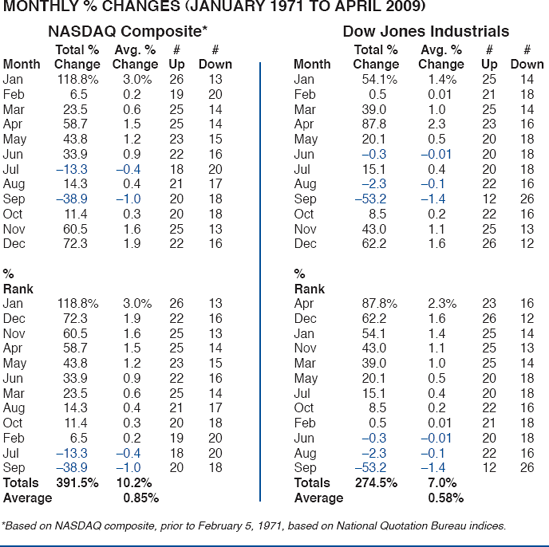
For comparison, Dow figures are shown. During this period, NASDAQ averaged a 0.85% gain per month, 47 percent more than the Dow's 0.58% per month. Between January 1971 and January 1982 NASDAQ's composite index doubled in the 12 years, while the Dow stayed flat. But while NASDAQ plummeted 77.9% from its 2000 highs to the 2002 bottom, the Dow only lost 37.8%.
MAY

The more feted by the media, the worse a pundit's accuracy.

Never overpay for a stock. More money is lost than in any other way by projecting above-average growth and paying an extra multiple for it.

Whoso neglects learning in his youth, loses the past and is dead for the future.

Look for an impending crash in the economy when the best-seller lists are filled with books on business strategies and quick-fix management ideas.
Friday Before Memorial Day Tends to Be Lackluster with Light Trading

The price of a stock varies inversely with the thickness of its research file.

June Almanac Investor Seasonalities: See Pages 114 and 116


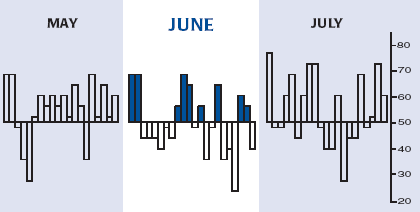
Market Probability Chart above is a graphic representation of the S&P 500 Recent Market Probability Calendar on page 124.
♦ The "summer rally" in most years is the weakest rally of all four seasons (page 70)♦Week after June Triple-Witching Day Dow down 17 of last 19 (page 76) ♦ RECENT RECORD: S&P up 9, down 5, average gain 0.1%, ranks seventh ♦ Much stronger for NASDAQ, average gain 1.9% last 14 years ♦ Watch out for end-of-quarter "portfolio pumping" on last day of June, Dow down 13 of last 18, NASDAQ down 4 straight ♦ Midterm election year Junes weak: worst Dow (−1.8%) and S&P (−1.9%) months, ranked eighth on NASDAQ −1.6% ♦ June ends NASDAQ's Best Eight Months.
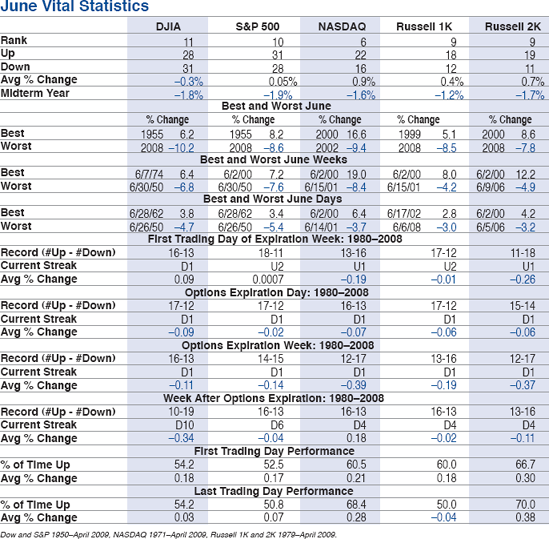
Last Day of June not hot for the Dow; But for stocks on NASDAQ, WOW!
MAY/JUNE
Memorial Day (Market Closed)

Never tell people how to do things. Tell them what to do and they will surprise you with their ingenuity.
First Trading Day in June, Dow Up 9 of Last 11, 2002 −2.2%, 2008 −1.1%

I'm very big on having clarified principles. I don't believe in being reactive. You can't do that in the markets effectively. I can't. I need perspective. I need a game plan.
Start Looking for NASDAQ MACD Sell Signal (Page 58) Almanac Investor Subscribers E-mailed Alert When It Triggers

All a parent can give a child is roots and wings.
Memorial Day Week Dow Down 7 of Last 13, Up 12 Straight 1984–1995

A generation from now, Americans may marvel at the complacency that assumed the dollar's dominance would never end.

The mind is not a vessel to be filled but a fire to be kindled.


NASDAQ's amazing eight-month run from November through June is hard to miss on pages 54 and 148. A $10,000 investment in these eight months since 1971 gained $290,636, versus a loss of $4,694 during the void that is the four-month period July to October.
Using the same MACD timing indicators on the NASDAQ as is done for the Dow (page 50) has enabled us to capture much of October's improved performance, pumping up NASDAQ's results considerably. Over the 38 years since NASDAQ began, the gain on the same $10,000 more than doubles to $718,420 and the loss during the four-month void increases to $7,845. Only four sizable losses occur during the favorable period and the bulk of NASDAQ's bear markets were avoided including the worst of the 2000–2002 bear.
Updated signals are e-mailed to our monthly newsletter subscribers as soon as they are triggered. For further information on how the MACD indicator is calculated, visit www.stocktradersalmanac.com.
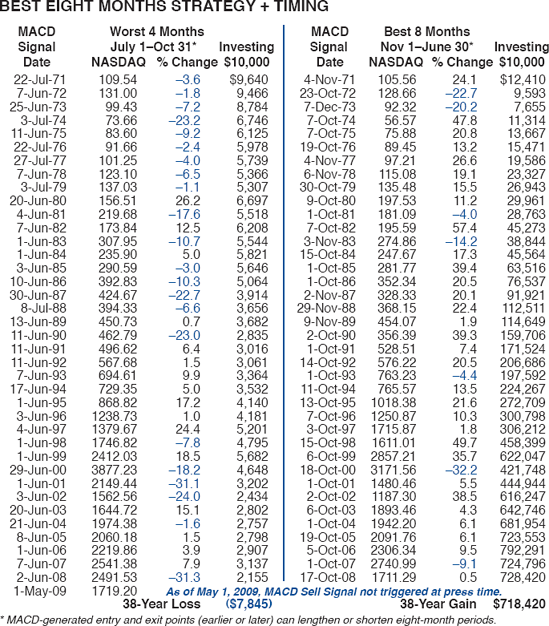
JUNE

Become more humble as the market goes your way.

The words "I am... are potent words; be careful what you hitch them to. The thing you're claiming has a way of reaching back and claiming you.
June Ends NASDAQ's "Best Eight Months" (Pages 54, 58, and 148)

I have a love affair with America, because there are no built-in barriers to anyone in America. I come from a country where there were barriers upon barriers.

...the most successful positions I've taken have been those about which I've been most nervous (and ignored that emotion anyway). Courage is not about being fearless; courage is about acting appropriately even when you are fearful.

When someone told me "We're going with you guys because no one ever got fired for buying Cisco (products)." That's what they used to say in IBM's golden age.


We first introduced this strategy to our newsletter subscribers in the October 2006 Almanac Investor. Recurring seasonal stock market patterns and the four-year Presidential Election/Stock Market Cycle (page 130) have been integral to our research since the first Almanac 43 years ago. Yale Hirsch discovered the Best Six Months in 1986 (page 48) and it has been a cornerstone of our seasonal investment analysis and strategies ever since.
Most of the market's gains have occurred during the Best Six Months and the market generally hits a low point every four years in the first (post-election) or second (midterm) year and exhibits the greatest gains in the third (pre-election) year. This new strategy combines the best of these two most pervasive market phenomena, the Best Six Months and the four-year cycle, timing entries and exits with MACD (pages 50 and 58).
We've gone back to 1949, one year further than the Best Six Months, in order to include the full four-year cycle that began with post-election year 1949. The accompanying diagram illustrates that only four trades every four years are needed to nearly triple the results of the Best Six Months. Buy and sell during the post-election and midterm years and then hold from the midterm MACD seasonal buy signal sometime after October 1 and hold until the post-election MACD seasonal sell signal sometime after April 1, approximately 2.5 years: better returns, less effort, lower transaction fees, and fewer taxable events.

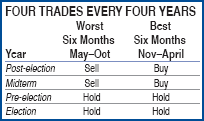
JUNE
June Triple Witching Week, Dow Up 5 Straight Years 2003–2007 Down Big in 2008, Off 3.8%

Today's Ponzi-style acute fragility and speculative dynamics dictate that he who panics first panics best.

The only function of economic forecasting is to make astrology look respectable.

Nothing has a stronger influence psychologically on their environment and especially on their children than the unlived life of the parent.

No other country can substitute for the U.S. The U.S. is still No. 1 in military, No. 1 in economy, No. 1 in promoting human rights and No. 1 in idealism. Only the U.S. can lead the world. No other country can.
June Triple Witching Day, Dow Up 4 of Last 6 Down Big in 2008, Off 1.8%

Today's generation of young people holds more power than any generation before it to make a positive impact on the world.

Father's Day

Over the last 12 years, the Dow Jones Industrial Average has gained more points on the first trading days of all months than all other days combined. While the Dow has only gained 589.99 points between September 2, 1997 (7622.42), and May 1, 2009 (8212.14), it is incredible that 4399.04 points were gained on the first trading days of these 141 months. The remaining 2794 trading days combined lost 3809.05 points during the period. This averages out to gains of 31.20 points on first days, in contrast to a loss of 1.36 points on all others.
Note that September 1997 through October 2000 racked up a total gain of 2632.39 Dow points on the first trading days of these 38 months (winners except for seven occasions). But between November 2000 and September 2002, when the 2000–2002 bear markets did the bulk of their damage, frightened investors switched from pouring money into the market on that day to pulling it out, 14 months out of 23, netting a 404.80 Dow point loss. At press time, the current bear market lopped off 767.17 Dow points on first days in 19 months November 2007–May 2009.
First days of August have performed worst, falling 8 times out of 11. January's first day has also been weak; down 5 of the last 10, as profit taking shifts to the opening of the New Year. In rising market trends, first days perform much better, as institutions are likely anticipating strong performance at each month's outset. S&P 500 first days track the Dow's pattern closely, but NASDAQ first days are not as strong, with weakness in January, April, July, August, and October.
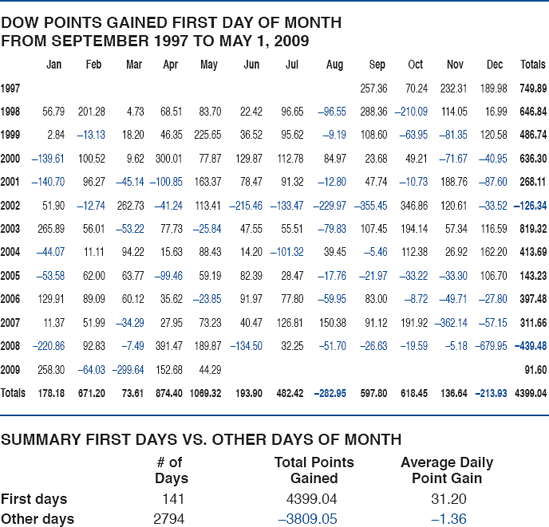
JUNE
Week After June Triple Witching, Dow Down 10 in a Row and 17 of Last 19 Down 4.2% in 2008

Whoso would be a man, must be a non-conformist... Nothing is at last sacred but the integrity of your own mind.

I don't know where speculation got such a bad name, since I know of no forward leap which was not fathered by speculation.

One machine can do the work of fifty ordinary men. No machine can do the work of one extraordinary man.
2008 Second Worst June Ever, Dow −10.2%, S&P −8.6%; Only 1930 Was Worse, NASDAQ −9.1%, June 2002 −9.4%

You can't grow long-term if you can't eat short-term. Anybody can manage short. Anybody can manage long. Balancing those two things is what management is.

The power to tax involves the power to destroy.

July Almanac Investor Seasonalities: See Pages 114 and 116


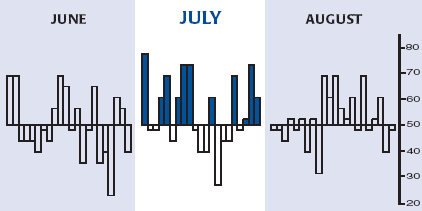
♦ July is the best month of the third quarter, except for NASDAQ (page 74) ♦ Start of second half brings an inflow of retirement funds ♦ First trading day Dow up 17 of last 20 ♦ Graph above shows strength in the beginning and end of July ♦ July closes well except if bear market in progress ♦ Huge gain in July usually provides better buying opportunity over next four months ♦ Start of NASDAQ's worst four months of the year (page 58) ♦ Midterm election Julys are ranked #5 Dow (up 9, down 6) and S&P (up 8, down 7) #12 NASDAQ (up 2, down 7).

When Dow and S&P in July are inferior, NASDAQ days tend to be even drearier.
JUNE/JULY

I have seen it repeatedly throughout the world: politicians get a country in trouble but swear everything is okay in the face of overwhelming evidence to the contrary.

When a country lives on borrowed time, borrowed money and borrowed energy, it is just begging the markets to discipline it in their own way at their own time. Usually the markets do it in an orderly way'except when they don't.
Last Day of Q2 Bearish for Dow, Down 13 of Last 18 But Bullish for NASDAQ, Up 12 of 17, Although Down 4 in a Row

The finest thought runs the risk of being irrevocably forgotten if we do not write it down.
First Trading Day in July, Dow Up 17 of Last 20

Try to surround yourself with people who can give you a little happiness, because you can only pass through this life once, Jack. You don't come back for an encore.

We can guarantee cash benefits as far out and at whatever size you like, but we cannot guarantee their purchasing power.

Independence Day


JULY
(Market Closed)

Banking establishments are more dangerous than standing armies; and that the principle of spending money to be paid by posterity, under the name of funding, is but swindling futurity on a large scale.
Watch out for Huge Market Gyrations (Both Up and Down) After July 4th

It's a buy when the 10-week moving average crosses the 30-week moving average and the slope of both averages is up.
July Begins NASDAQ's "Worst Four Months" (Pages 54, 58, and 148)

We're not believers that the government is bigger than the business cycle.

Financial markets will find and exploit hidden flaws, particularly in untested new innovations'and do so at a time that will inflict the most damage to the most people.
July Is the Best Performing Dow and S&P Month of the Third Quarter

The greatest good you can do for another is not just to share your riches, but to reveal to him his own.


Since 1989, Monday*, Tuesday, and Wednesday have been the most consistently bullish days of the week for the Dow, Thursday and Friday* the most bearish, as traders have become reluctant to stay long going into the weekend. Since 1989, Mondays, Tuesdays, and Wednesdays gained 9194.60 Dow points, while Thursday and Friday combined for a total loss of 3735.39 points. Also broken out are the last eight and a third years to illustrate Monday's and Friday's poor performance in bear market years 2001–2002 and 2008–2009. During uncertain market times traders often sell before the weekend and are reluctant to jump in on Monday. See pages 52, 66, and 141–144 for more.

JULY
Monday Before July Expiration, 2008 Broke Dow 5-Year Bull Run

The higher a people's intelligence and moral strength, the lower will be the prevailing rate of interest.

The most valuable executive is one who is training somebody to be a better man than he is.

Tell me and I'll forget; show me and I may remember; involve me and I'll understand.

Imagination is more important than knowledge.
July Expiration Day, Dow Down 6 of Last 9, Off 390 Points (4.6%) in 2002

Have not great merchants, great manufacturers, great inventors done more for the world than preachers and philanthropists. Can there be any doubt that cheapening the cost of necessities and conveniences of life is the most powerful agent of civilization and progress?


Most years, especially when the market sells off during the first half, prospects for the perennial summer rally become the buzz on the street. Parameters for this "rally" were defined by the late Ralph Rotnem as the lowest close in the Dow Jones Industrials in May or June to the highest close in July, August, or September. Such a big deal is made of the summer rally that one might get the impression the market puts on its best performance in the summertime. Nothing could be further from the truth! Not only does the market "rally" in every season of the year, but it does so with more gusto in the winter, spring, and fall than in the summer.
Winters in 46 years averaged a 13.0% gain as measured from the low in November or December to the first quarter closing high. Spring rose 11.1% followed by fall with 10.7%. Last and least was the average 9.0% summer rally. Even 2003's impressive 14.3% summer rally was outmatched by spring and fall. Nevertheless, no matter how thick the gloom or grim the outlook, don't despair! There's always a rally for all seasons, statistically.

JULY

Individualism, private property, the law of accumulation of wealth and the law of competition... are the highest result of human experience, the soil in which, so far, has produced the best fruit.

I never hired anybody who wasn't smarter than me.
Week After July Expiration, Dow Down 7 of Last 11, 2007 −4.2%, 2008 −4.3%

Follow the course opposite to custom and you will almost always do well.

The job of central banks: To take away the punch bowl just as the party is getting going.

Major bottoms are usually made when analysts cut their earnings estimates and companies report earnings which are below expectations.



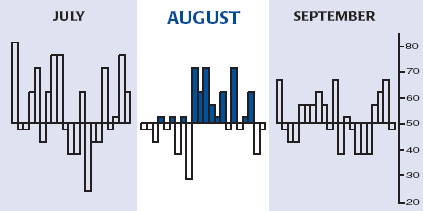
Market Probability Chart above is a graphic representation of the S&P 500 Recent Market Probability Calendar on page 124.
♦ Harvesting made August the best stock market month 1901–1951 ♦ Now that about 2% farm, August is the second-worst Dow and S&P month since 1987, and fifth-worst NASDAQ month (2000 up 11.7%, 2001 down 10.9%); up across the board last three years ♦ Shortest bear in history (45 days) caused by turmoil in Russia, currency crisis and hedge fund debacle ended here in 1998, 1344.22-point drop in the Dow, second worst behind October 2008, off 15.1% ♦ Saddam Hussein triggered a 10.0% slide in 1990 ♦ Best Dow gains: 1982 (11.5%) and 1984 (9.8%) as bear markets ended ♦ Next to last day, S&P was up only twice in last 13 years.

August's a good month to go on vacation; Trading stocks will likely lead to frustration.
JULY/AUGUST
July Closes Well, but Can End Poorly If Bear Market in Progress

Women are expected to do twice as much as men in half the time and for no credit. Fortunately, this isn't difficult.

What counts more than luck, is determination and perseverance. If the talent is there, it will come through. Don't be too impatient.
Beware the "Summer Rally" Hype Historically the Weakest Rally of All Seasons (Page 70)

I have a simple philosophy. Fill what's empty. Empty what's full. And scratch where it itches.

If each of us hires people who are smaller than we are, we shall become a company of dwarfs. But if each of us hires people who are bigger than we are, we shall become a company of giants.

Stocks are super-attractive when the Fed is loosening and interest rates are falling. In sum: Don't fight the Fed!

August Almanac Investor Seasonalities: See Pages 114 and 116

We have observed over the years that the investment calendar reflects the annual, semiannual, and quarterly operations of institutions during January, April, and July. The opening month of the first three quarters produces the greatest gains in the Dow Jones Industrials and the S&P 500. NASDAQ's record differs slightly.
The fourth quarter had behaved quite differently since it is affected by year-end portfolio adjustments and presidential and congressional elections in even-numbered years. Since 1991, major turnarounds have helped October join the ranks of bullish first months of quarters. October has transformed into a bear-killing-turnaround month, posting some mighty gains in seven of the last 11 years, although 2008 sharply reversed this trend. (See pages 152–160.)
After experiencing the most powerful bull market of all time during the 1990s, followed by the ferocious bear market early in the millennium, we divided the monthly average percent changes into two groups: before 1991 and after. Comparing the month-by-month quarterly behavior of the three major U.S. averages in the table, you'll see that first months of the first three quarters perform best overall. Nasty sell-offs in April 2000, 2002, 2004, and 2005 and July 2000–2002 and 2004, hit the NASDAQ hardest. The bear market that began in October 2007 that more than cut the markets in half at its March 2009 lows has taken a toll on every first month except April. October 2008 was the worst month in a decade. (See pages 152–160.)
Between 1950 and 1990, the S&P 500 gained 1.3% (Dow, 1.4%) on average in first months of the first three quarters. Second months barely eked out any gain, while third months, thanks to March, moved up 0.23% (Dow, 0.07%) on average. NASDAQ's first month of the first three quarters averages 1.67% from 1971–1990, with July being a negative drag.

AUGUST
First Trading Day in August Weak, Dow Down 9 of Last 12, Up 1.1% in 2007

It's not the strongest of the species (think "traders") that survive, nor the most intelligent, but the one most responsive to change.

I believe in the exceptional man—the entrepreneur who is always out of money, not the bureaucrat who generates cash flow and pays dividends.

Of 120 companies from 1987 to 1992 that relied primarily on cost cutting to improve the bottom line, 68 percent failed to achieve profitable growth during the next five years.
First Nine Trading Days of August Are Historically Weak

Based on my own personal experience—both as an investor in recent years and an expert witness in years past—rarely do more than three or four variables really count. Everything else is noise.

A bull market tends to bail you out of all your mistakes. Conversely, bear markets make you PAY for your mistakes.


Options expire the third Friday of every month but in March, June, September, and December a powerful coven gathers. Since the S&P index futures began trading on April 21, 1982, stock options, index options as well as index futures all expire at the same time four times each year—known as Triple Witching. Traders have long sought to understand and master the magic of this quarterly phenomenon.
The market for single-stock and ETF futures (1193 at this writing) is currently experiencing rapid growth in the number of issues. however, their impact on the market has thus far been subdued. As their availability continues to expand, trading volumes and market influence are also likely to broaden. Until such time, we do not believe the term "quadruple witching" is applicable just yet.
We have analyzed what the market does prior, during and following Triple Witching expirations in search of consistent trading patterns. Here are some of our findings of how the Dow Jones Industrials perform around Triple-Witching Week (TWW).
TWWs became more bullish since 1990, except in the second quarter.
Following weeks became more bearish. Since Q1 2000, only 11 of 36 were up, and 5 occurred in December.
TWWs have tended to be down in flat periods and dramatically so during bear market.
DOWN WEEKS TEND TO FOLLOW DOWN TWWs is a most interesting pattern. Since 1991, of 25 down TWWs, 20 following weeks were also down. This is surprising inasmuch as the previous decade had an exactly opposite pattern: There were 13 down TWWs then, but 12 up weeks followed them.
TWWs in the second and third quarter (Worst Six Months May through October) are much weaker and the weeks following, horrendous. But in the first and fourth quarter (Best Six Months period November through April) only the week after Q1 expiration is negative.
Throughout the Almanac you will also see notations on the performance of Mondays and Fridays of TWW as we place considerable significance on the beginnings and ends of weeks (pages 52, 66, 68, and 141–144).
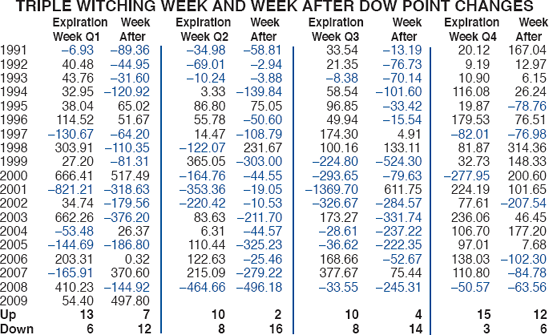
AUGUST
August Worst Dow and S&P Month 1988–2005; Up Last 3 Years, 2nd Best Harvesting Made August Best Dow Month 1901–1951, 2nd Worst NASDAQ

The difficult we do immediately; the impossible takes a little longer.

Capitalism is the legitimate racket of the ruling class.

If you bet on a horse, that's gambling. If you bet you can make three spades, that's entertainment.
If you bet cotton will go up three points, that's business. See the difference?

If investing is entertaining, if you're having fun, you're probably not making any money. Good investing is boring.
Mid-August Stronger Than Beginning and End

First-rate people hire first-rate people; second-rate people hire third-rate people.


Normally, major corrections occur sometime in the first or second years following presidential elections. In the last 12 midterm election years, bear markets began or were in progress nine times—we experienced bull years in 1986 and 2006, while 1994 was flat.
The puniest midterm advance, 14.5% from the 1946 low, was during the industrial contraction after World War II. The next four smallest advances were: 1978 (OPEC–Iran) 21.0%, 1930 (economic collapse) 23.4%, 1966 (Vietnam) 26.7%, and 2006 (Iraq) 32.8%.
Since 1914, the Dow has gained 49.2% on average from its midterm election year low to its subsequent high in the following pre-election year. A swing of such magnitude is equivalent to a move from 8000 to 12000 or from 10000 to 15000.
Conversely, since 1913 the Dow has dropped −21.4% on average from its post-election-year high to its subsequent low in the following midterm year. At press time, the Dow's 2009 post-election year high is 9034.69. A 21.4% decline would put the Dow back at 7191.61 at the 2010 midterm bottom. With the financial crisis only beginning to ease with the faintest signs of recovery at press time, a decline back to this level or below is certainly not out of the question. Whatever the level, the rally off the 2010 midterm low could be one of the best buying opportunities of the twenty-first century.
Pretty impressive seasonality! There is no reason to think the quadrennial Presidential Election/Stock Market Cycle will not continue. Page 130 shows how effectively most presidents "managed" to have much stronger economies in the third and fourth years of their terms than in their first two.

AUGUST
Monday Before August Expiration, Dow Up 11 of Last 14

The usual bull market successfully weathers a number of tests until it is considered invulnerable, whereupon it is ripe for a bust.

Sell stocks whenever the market is 30% higher over a year ago.

The ability to foretell what is going to happen tomorrow, next week, next month, and next year.
And to have the ability afterwards to explain why it didn't happen.

If I owe a million dollars I am lost. But if I owe $50 billion the bankers are lost.
August Expiration Day Bullish Lately, Dow Up 6 in a Row 2003–2008 Up 233 Points (1.8%) in 2007

Don't delay! A good plan, violently executed now, is better than a perfect plan next week. War is a very simple thing, [like stock trading] and the determining characteristics are self-confidence, speed, and audacity.


While there's a rally for every season (page 70), almost always there's a decline or correction, too. Fortunately, corrections tend to be smaller than rallies, and that's what gives the stock market its long-term upward bias. In each season the average bounce outdoes the average setback. On average, the net gain between the rally and the correction is smallest in summer and fall.
The summer setback tends to be slightly outdone by the average correction in the fall. Tax selling and portfolio cleaning are the usual explanations—individuals sell to register a tax loss and institutions like to get rid of their losers before preparing year-end statements. The October jinx also plays a major part. Since 1964, there have been 17 fall declines of over 10%, and in 10 of them (1966, 1974, 1978, 1979, 1987, 1990, 1997, 2000, 2002, and 2008) much damage was done in October, where so many bear markets end. Recent October lows were also seen in 1998, 1999, 2004, and 2005. Most often, it has paid to buy after fourth quarter or late third quarter "waterfall declines" for a rally that may continue into January or even beyond. War in Iraq affected the pattern in 2003. Anticipation of our invasion put the market down in the Q1. Quick success rallied stocks through summer. Financial crisis affected the pattern in 2008–2009 producing the worst winter decline since 1932.

AUGUST

The choice of starting a war this [pre-election] spring was made for political as well as military reasons... [The president] clearly does not want to have a war raging on the eve of his presumed reelection campaign.
End of August Stronger Last 5 Years

Q. What kind of grad students do you take? A. I never take a straight-A student. A real scientist tends to be critical, and somewhere along the line, they had to rebel against their teachers.

People who can take a risk, who believe in themselves enough to walk away [from a company], are generally people who bring about change.

A loss never bothers me after I take it. I forget it overnight. But being wrong— not taking the loss—that is what does damage to the pocketbook and to the soul.

Keep away from people who try to belittle your ambitions. Small people always do that, but the really great make you feel that you, too, can become great.




Market Probability Chart above is a graphic representation of the S&P 500 Recent Market Probability Calendar on page 124.
♦ Start of business year, end of vacations, and back to school made September a leading barometer month in first 60 years of 20th century, now portfolio managers back after Labor Day tend to clean house ♦ Biggest % loser on the S&P, Dow and NASDAQ (pages 44 and 54) ♦ Streak of four great Dow Septembers averaging 4.2% gains ended in 1999 with six losers in a row averaging −5.9% (see page 152), up three straight 2005–2007, down 6% in 2008 ♦ Day after Labor Day Dow up 12 of last 15 ♦ S&P opened strong 11 of last 14 years but tends to close weak due to end-of-quarter mutual fund portfolio restructuring ♦ September Triple-Witching Week is dangerous, week after pitiful (see page 76).
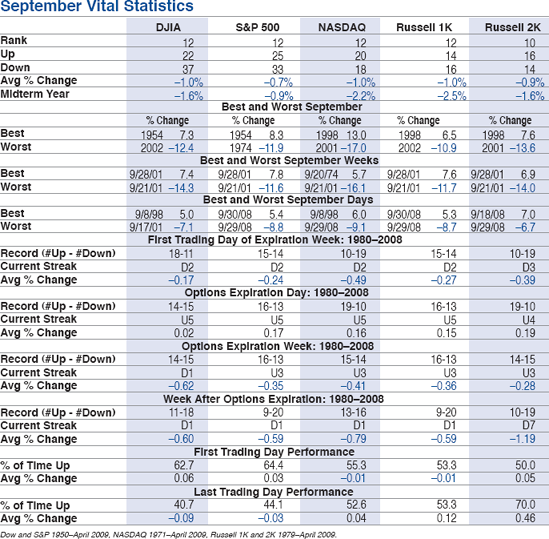
September is when leaves and stocks tend to fall; On Wall Street it's the worst month of all.
AUGUST/SEPTEMBER
August's Next-to-Last Trading Day, S&P Up Only Twice in Last 13 Years

A "tired businessman" is one whose business is usually not a successful one.

Sometimes the best investments are the ones you don't make.
First Trading Day in September, S&P Up 11 of Last 14 Back-to-Back Huge Gains 1997 and 1998, Up 3.1% and 3.9%

Everything possible today was at one time impossible. Everything impossible today may at some time in the future be possible.

Don't confuse brains with a bull market.
Major Market Instability Leading into Labor Day Lately Triple Digit Dow Moves Have Become Commonplace

Small volume is usually accompanied by a fall in price; large volume by a rise in price.


The Stock Trader's Almanac has tracked holiday seasonality annually since the first edition in 1968. Stocks used to rise on the day before holidays and sell off the day after, but nowadays, each holiday moves to its own rhythm. Eight holidays are separated into seven groups. Average percent changes for the Dow, S&P 500, NASDAQ, and Russell 2000 are shown.
The Dow and S&P consist of blue chips and the largest cap stocks, whereas NASDAQ and the Russell 2000 would be more representative of smaller-cap stocks. This is evident on the last day of the year with NASDAQ and the Russell 2000 having a field day, while their larger brethren in the Dow and S&P are showing losses on average.
Thanks to the Santa Claus Rally, the three days before and after New Year's Day and Christmas are best. NASDAQ and the Russell 2000 average gains of 1.4% to 1.8% over the six-day spans. However, trading around the first day of the year has been mixed. Traders have been selling more the first trading day of the year recently, pushing gains and losses into the New Year.
Bullishness before Labor Day and after Memorial Day is affected by strength the first day of September and June. The worst day after a holiday is the day after Easter. Surprisingly, the following day is one of the best second days after a holiday, right up there with the second day after New Year's Day.
Presidents' Day is the least bullish of all the holidays, bearish the day before and three days after. NASDAQ has dropped 17 of the last 20 days before Presidents' Day (Dow, 15 of 20; S&P, 16 of 20; Russell 2000, 12 of 20).
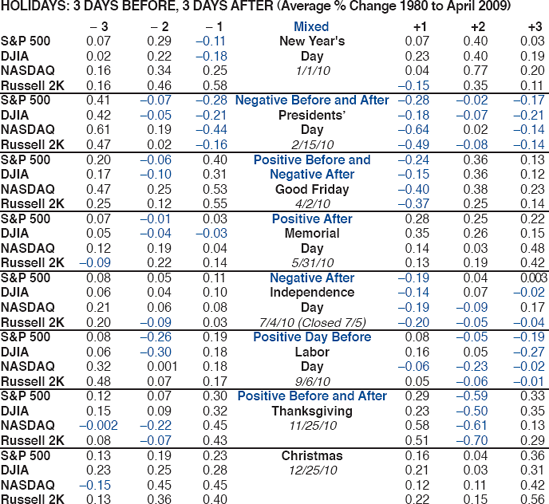
SEPTEMBER
Labor Day (Market Closed)

English stocks... are springing up like mushrooms this year... forced up to a quite unreasonable level and then, for most part, collapse. In this way, I have made over 400 pounds... [Speculating] makes small demands on one's time, and it's worth while running some risk in order to relieve the enemy of his money.
Day After Labor Day, Dow Up 12 of Last 15, 1997 Up 3.4%, 1998 Up 5.0%

Behold, my son, with what little wisdom the world is ruled.

The inherent vice of capitalism is the unequal sharing of blessings; the inherent virtue of socialism is the equal sharing of miseries.
Rosh Hashanah

Live beyond your means; then you're forced to work hard, you have to succeed.

The whole problem with the world is that fools and fanatics are always so certain of themselves, but wiser people so full of doubts.
2001 4-Day Market Closing, Longest Since 9-Day Banking Moratorium in March 1933


Examining market performance on a quarterly basis reveals several intriguing and helpful patterns. Fourth-quarter market gains have been magical, providing the greatest and most consistent gains over the years. First-quarter performance runs a respectable second. This should not be surprising, as cash inflows, trading volume, and buying bias are generally elevated during these two quarters.
Positive market psychology hits a fever pitch as the holiday season approaches and does not begin to wane until spring. Professionals drive the market higher as they make portfolio adjustments to maximize yearend numbers. Bonuses are paid and invested around the turn of the year.
The market's sweet spot of the four-year cycle begins in the fourth quarter of the midterm year. The best two-quarter span runs from the fourth quarter of the midterm year through the first quarter of the pre-election year, averaging 14.4% for the Dow, 15.0% for the S&P 500, and an amazing 24.0% for NASDAQ.
Quarterly strength fades in the latter half of the pre-election year, but stays impressively positive through the election year. Losses dominate the first and third quarter of post-election years and the first and second quarters of midterm years. Once again, the global financial crisis trumped seasonality, hammering the fourth quarter of 2008 onto the list of 10 worst quarters of all time (see page 168).

SEPTEMBER
Markets Mugged Monday Before September Triple Witching 2008 Dow Lost 504 Points (−4.4%), S&P −4.7%, NASDAQ −3.6%

If we did all the things we are capable of doing, we would literally astound ourselves.

Whenever a well-known bearish analyst is interviewed [Cover story] in the financial press it usually coincides with an important near-term market bottom.
Clifdroke.com, 11/15/04)Expiration Week 2001, Dow Lost 1370 Points (14.3%) 2nd Worst Weekly Point Loss Ever, 5th Worst Week Overall

The only title in our democracy superior to that of president is the title of citizen.

Genius is the ability to put into effect what is in your mind.
September Triple Witching, Dow Up 5 Straight and 6 of Last 7

We go to the movies to be entertained, not see rape, ransacking, pillage, and looting. We can get all that in the stock market.
Yom Kippur


For many years the last day plus the first four days were the best days of the month. The market currently exhibits greater bullish bias from the last three trading days of the previous month through the first two days of the current month, and now shows significant bullishness during the middle three trading days, 9 to 11, due to 401(k) cash inflows (see pages 145 and 146). This pattern was not as pronounced during the boom years of the 1990s, with market strength all month long. It returned in 2000 with monthly bullishness at the ends, beginnings and middles of months versus weakness during the rest of the month. In 2008 the "Super 8" were mauled by the bear, and the trend has continued into early 2009. A reversal of this trend could signal the demise of the bear.
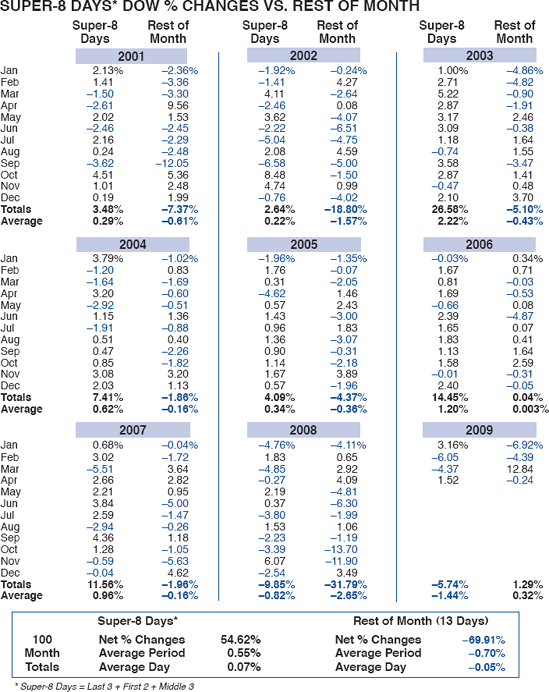
SEPTEMBER

Pretend that every single person you meet has a sign around his or her neck that says, "Make me feel important." Not only will you succeed in sales, you will succeed in life.

Those that forget the past are condemned to repeat its mistakes, and those that mis-state the past should be condemned.
Week After September Triple Witching Dow Down 6 of Last 7 Five in a Row 2002–2006 with Heavy Losses 2002–2005

If the winds of fortune are temporarily blowing against you, remember that you can harness them and make them carry you toward your definite purpose, through the use of your imagination.

In the stock market, those who expect history to repeat itself exactly are doomed to failure.

In order to be great writer (or "investor"), a person must have a built-in, shockproof crap detector.




Market Probability Chart above is a graphic representation of the S&P 500 Recent Market Probability Calendar on page 124.
♦ Known as the jinx month because of crashes in 1929, 1987, the 554-point drop on October 27, 1997, back-to-back massacres in 1978 and 1979, Friday the 13th in 1989, and the meltdown in 2008 ♦ Yet October is a "bear killer" and turned the tide in 11 post–WWII bear markets: 1946, 1957, 1960, 1962, 1966, 1974, 1987, 1990, 1998, 2001, and 2002 ♦ First October Dow top in 2007, 20-year 1987 crash anniversary −2.6% ♦ Worst six months of the year ends with October (page 48) ♦ No longer worst month (pages 44 and 56) ♦ Best Dow, S&P, and NASDAQ month from 1993 to 2007 ♦ October is a great time to buy ♦ Big October gains five years 1999–2003 after atrocious Septembers ♦ Can get into Best Six Months earlier using MACD (page 50).
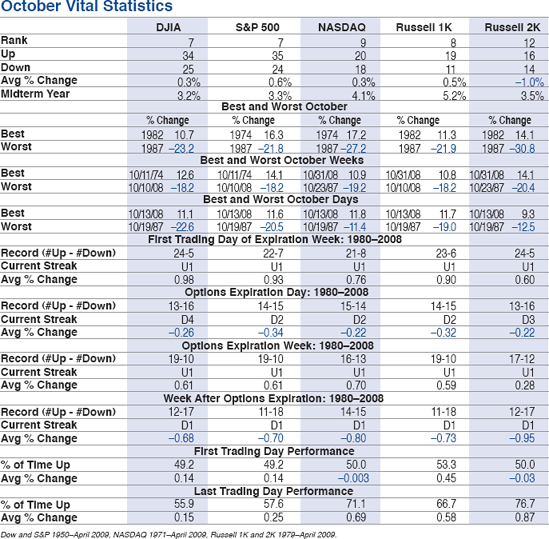
October has killed many a bear; Buy tech stocks and soon wear a grin ear to ear.
SEPTEMBER/OCTOBER

History shows that once the United States fully recognizes an economic problem and thereby places all its efforts on solving it, the problem is about to be solved by natural forces.

In every generation, there has to be some fool who will speak the truth as he sees it.

To know values is to know the meaning of the market.
Q3 End Brings Institutional Portfolio Window Dressing and Heavy Selling Last Day of Q3, Dow Down 8 of Last 12, Massive 4.7% Rally in 2008

Almost any insider purchase is worth investigating for a possible lead to a superior speculation. But very few insider sales justify concern.
First Trading Day in October, NASDAQ Up 5 of Last 7 2002–2004 Up 3.6%, 2.5%, and 2.4%

Unless you love EVERYBODY, you can't sell ANYBODY.

October Almanac Investor Seasonalities: See Pages 114 and 116

Bailout Nation: How Greed and Easy Money Corrupted Wall Street and Shook the World Economy
By Barry Ritholtz
It is with great pleasure and much anticipation that we name Barry Ritholtz's new book, Bailout Nation, the Best Investment Book of 2010. As devout Stock Trader's Almanac readers know, the 2007 edition was dedicated to Mr. Ritholtz with the following:
One of the brightest minds and irreverent voices on Wall Street today, we are honored to consider Barry a colleague and a friend. His adroit commentary is unique in that it is both classical in nature and out-of-the-box by design. Barry truly is one of Wall Street's important thinkers and rising stars.
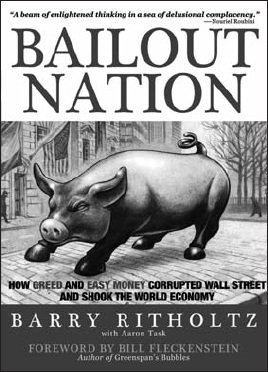
Mr. Ritholtz is a rising star no more. He is now one of the most respected voices on Wall Street. A media regular on Bloomberg TV and Radio, CNBC, Fox, and PBS, Barry's perspectives are also quoted in The Wall Street Journal, Barron's, Forbes, and other media. His blog, The Big Picture, is among the most popular financial sites in the blogosphere.
Bailout Nation is a no-holds-barred look at the events leading up to the financial crisis of 2008 and the fallout thus far. Brutally honest, Mr. Ritholtz shares his decades of insider experience in explaining the lead up and eventual repercussions of the biggest financial meltdown in a generation.
Delving deep into history, Bailout Nation provides an entertaining and informative look at how years of easy money led us down the primrose path and ultimately were the catalyst of the massive bailouts of many, once proud industries. The book addresses the question of why some groups were saved and others were left to crumble. Ritholtz takes a long hard look at the impact bailouts have and delineates three inherent problems with them in general. Needless to say, Barry is not a fan.
Bailout Nation calls out the missteps and mistakes of the key players, including Alan Greenspan, former Senator Phil Gramm, Presidents Bush and Clinton, Treasury Secretaries Robert Rubin and Larry Summers, the biggest Wall Street firms, the ratings agencies, and Washington regulators.
Not just an indictment, Barry also shares his visions of the future and ideas on investing in the new world order. He offers advice and input on the future of the housing and credit messes. He also relates methods he feels should be implemented in fixing the economy and improving monetary policy.
Bailout Nation is a must read. Its historical importance and vision are exactly why Barry is a highly acclaimed financial commentator. His guiding voice and prescient analysis during these turbulent times are a refreshing dose of honest reflection and should be heeded by all as we head into the new economy.
OCTOBER
October Ends Dow and S&P "Worst Six Months" (Pages 44, 48, 50, and 147) and NASDAQ "Worst Four Months" (Pages 54, 58, and 148)

I was in search of a one-armed economist so that the guy could never make a statement and then say: "on the other hand."

I've continued to recognize the power individuals have to change virtually anything and everything in their lives in an instant. I've learned that the resources we need to turn our dreams into reality are within us, merely waiting for the day when we decide to wake up and claim our birthright.
Start Looking for MACD BUY Signals (Pages 50 and 58) Almanac Investor Subscribers E-mailed Alerts When They Trigger

Governments last as long as the under-taxed can defend themselves against the over-taxed.

Corporate guidance has become something of an art. The CFO has refined and perfected his art, gracefully leading on the bulls with the calculating grace and cunning of a great matador.
Dow Lost 1874 Points (18.2%) on the Week Ending 10/10/08; Worst Dow Week in the History of Wall Street

I will never knowingly buy any company that has a real-time quote of their stock price in the building lobby.


Bailout Nation: How Greed and Easy Money Corrupted Wall Street and Shook the World Economy, Barry Ritholtz, Wiley, $24.95. 2010 Best Investment Book of the Year.
Double Your Money in America's Finest Companies®: The Unbeatable Power of Rising Dividends, Bill Staton, Wiley, $39.95. Inaugural edition of our new Almanac Investor Book series. In his snappy, entertaining, down-home style Staton shares his simple, time-tested method of investing in the highest-quality companies with long histories of annual increases in earnings and dividends that historically outperform the market and most money managers. The valuable appendix contains a complete listing of America's Finest Companies®.
The MAGNET® Method of Investing: Find, Trade, and Profit from Exceptional Stocks, Jordan L. Kimmel, Wiley, $60.00. Almanac Investor Book series second installment. Kimmel candidly exposes the inherent shortcomings of rote asset allocation and overdiversification in plain language and details characteristics of top performing stocks. He shows how his MAGNET® Stock Selection Process isolates future runaway stocks and how to focus your efforts on these hidden values at the right time. Includes full back-test and current Magnet Stocks.
Commodity Trader's Almanac 2010, John L. Person, Jeffrey A. Hirsch, Wiley, $39.95. This fourth edition is the second with John Person. Following up on last year's successful introduction of trading stocks and ETFs related to commodity seasonalities in addition to the underlying, we have added several new wrinkles and expanded the trading guidance in the same mold as the Stock Trader's Almanac. From crude oil to cocoa and beans to bonds, this book explores patterns, seasonalities, strategies, and has an historical databank on 19 major commodities.
Seasonal Stock Market Trends: The Definitive Guide to Calendar-Based Stock Market Trading, Jay Kaeppell, Wiley, $60.00. A new twist on market participant behavior and the seasonalities they create.
The Daily Trading Coach: 101 Lessons for Becoming Your Own Trading Psychologist, Brett N. Steenbarger, Wiley, $45.00. Improve your trading returns by tapping into and leveraging your own inner strengths.
The Seven Rules of Wall Street: Crash-Tested Investment Strategies That Beat the Market, Sam Stovall, McGraw-Hill, $21.95. Great insights from the chief investment strategist of Standard & Poor's Equity Research.
The Return of Depression Economics, Paul Krugman, Norton, $24.95. One the world's top economists and a Nobel Laureate. We never miss any of his twice-weekly New York Times columns. His advice has been remarkable.
The Ten Roads to Riches: The Ways the Wealthy Got There (And How You Can Too), Ken Fisher, Wiley, $24.95. How can one ignore a book written by a billionaire who manages around $45 billion? He is also a columnist at Forbes.
OCTOBER
Columbus Day (Bond Market Closed) Monday Before October Expiration, Dow Up 24 of 29

People's spending habits depend more on how wealthy they feel than with the actual amount of their current income.

Brazil is the country of the future and always will be.

At the age of 24, I began setting clear, written goals for each area of my life. I accomplished more in the following year than I had in the previous 24.

Every time everyone's talking about something, that's the time to sell.
October Expiration Day, Dow Down 4 Straight and 5 of Last 6 Eked Out a Modest 0.4% Gain in 2004

For a country, everything will be lost when the jobs of an economist and a banker become highly respected professions.


The World Is Curved: Hidden Dangers to the World Economy, David M. Smick, Portfolio, $26.95. Never saw such a huge number of top names recommending a book before. (Alan Greenspan, Bill Bradley, Lawrence Summers, George Shultz, Barton Biggs, etc.) He must be a powerhouse in economics.
Option Strategies for Directionless Markets: Trading with Butterflies, Iron Butterflies, and Condors, Anthony J. Saliba, Bloomberg, $39.95. Great tactics from a trading professional.
Option Spread Strategies: Trading Up, Down and Sideways Markets, Anthony J. Saliba, Bloomberg Press, $39.95. How to simultaneously buy/sell offsetting contracts on a single underlying security.
The Next 100 Years: A Forecast for the 21st Century, George Friedman, Doubleday, $25.95. Some of the changes we can expect around the world during the 21st century. Predicts the United States will experience a Golden Age in the second half of the century and that Mexico will emerge as an important world power.
The Heretics of Finance: Conversations with Leading Practitioners of Technical Analysis, Andrew W. Lo and Jasmina Hasanhodzic, Bloomberg Press, $29.95. Loads of strategies and tactics from 13 Wall Street greats. Found and underlined a number of bits from the minds of a few of these giants.
Call Me Ted, Ted Turner, Grand Central, $30.00. I really enjoyed reading about Ted's many business exploits. Even got a good quote from his father.
Billion Dollar Green: Profit from the Eco Revolution, Tobin Smith, Wiley, $27.95. As President Obama is committed to getting us off our addiction to foreign oil, investors should concentrate on solar, wind, hydrogen, green cars/buildings, etc.
Planet Water: Investing in the World's Most Valuable Resource, Steve Hoffmann, Wiley, $47.95. It's quite obvious that water remains one of the world's most serious problems and it is not going to go away.
The Guru Investor: How to Beat the Market Using History's Best Investment Strategies, John P. Reese with Jack M. Forehand, Wiley, $27.95. Offers a step-by-step guide to the investment methodologies of ten of the top well-known investors. Shows how to combine the proven strategies of these gurus into an investing system.
Financial Darwinism: Create Value or Self-Destruct in a World of Risk, Leo M. Tilman, Wiley, $29.95. The 2006 Nobel Laureate in Economics introduces an evolutionary thesis about the tectonic financial shift that has taken place over the past quarter century.
Trade Like a Pro: 15 High-Profit Trading Strategies, Noble DraKoln, Wiley, $70.00. A look at trading through the eyes of a professional.
Morningstar Fund Spy: Morningstar's Inside Secrets to Selecting Mutual Funds That Outperform, Russel Kinnel, Wiley, $24.95. Demonstrates how to pick funds that will outperform their peers over the long haul.
OCTOBER

I have but one lamp by which my feet (or "investments) are guided, and that is the lamp of experience. I know of no way of judging the future but by the past.
Crash of October 19, 1987, Dow Down 22.6% in One Day

Of the S&P 500 companies in 1957, only 74 were still on the list in 1998 and only 12 outperformed the index itself over that period. By 2020, more than 375 companies in the S&P 500 will consist of companies we don't know today.

Wall Street has a uniquely hysterical way of thinking the world will end tomorrow but be fully recovered in the long run, then a few years later believing the immediate future is rosy but that the long term stinks.

He who knows nothing is confident of everything.
Late October is Time to Buy Depressed Stocks Especially Techs and Small Caps

Drawing on my fine command of language, I said nothing.


Presidential election years tend to produce high drama and frenetic campaigns. Midterm years with only local or state candidates running are less stressful. Could this be the reason for the bullishness that seems to occur in the five days before and three days after midterm congressional elections? We don't think so. So many bear markets seem to occur in midterm years, very often bottoming in October. Also, major military involvements began or were in their early stages in midterm years, such as: World War II, Korea, Vietnam, Kuwait, and Iraq. Solidly bullish midterm years as 1954, 1958, 1986, and 2006 were exceptions. With so many negative occurrences in midterm years, perhaps the opportunity for investors to make a change for the better by casting their votes translates into an inner bullish feeling before and after midterm elections.
An impressive 2.7% has been the average gain during the eight trading days surrounding midterm election days since 1934. This is equivalent to roughly 230 Dow points per day at present levels. There was only one losing period in 1994, when the Republicans took control of both the House and the Senate for the first time in 40 years. Three other midterm switches occurred in 1946, when control of Congress passed to the Republicans for just two years, in 1954, when Democrats took back control, and in 2006, when Democrats regained control.
There were 10 occasions when the percentage of House seats lost by the president's party was in double digits. The average market gain during the eight-day trading period was 2.1%. In contrast, the average gain in the eight occasions when there were no losses, or losses were in single digits, gains averaged 3.4%.
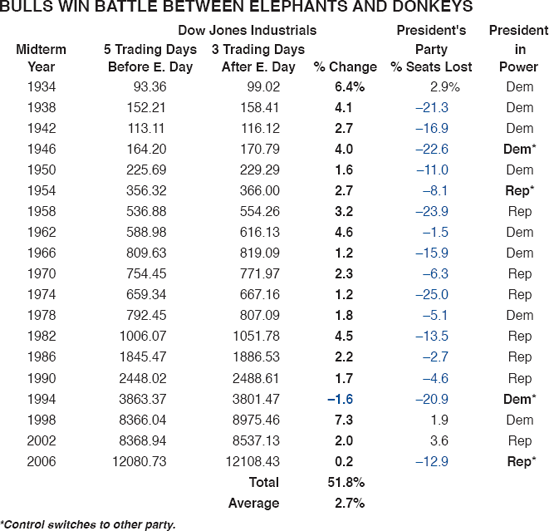
OCTOBER

Technology has no respect for tradition.

Knowing others is intelligence; knowing yourself is true wisdom. Mastering others is strength; mastering yourself is true power.

Bill Gates' One-Minus Staffing: For every project, figure out the bare minimum of people needed to staff it. Cut to the absolute muscle and bones, then take out one more. When you understaff, people jump on the loose ball. You find out who the real performers are. Not so when you're overstaffed. People sit around waiting for somebody else to do it.
81st Anniversary of 1929 Crash, Dow Down 23.0% in Two Days, October 28 and 29

The world hates change, but it is the only thing that has brought progress.

There have been three great inventions since the beginning of time: The fire, the wheel, and central banking.
Halloween



Market Probability Chart above is a graphic representation of the S&P 500 Recent Market Probability Calendar on page 124.
♦ #2 S&P month and #3 on Dow since 1950, #3 on NASDAQ since 1971 (pages 44 and 54) ♦ Start of the "Best Six Months" of the year (page 48), NASDAQ's Best Eight Months and Best Three (pages 147 and 148) ♦ Simple timing indicator almost triples "Best Six Months" strategy (page 50), doubles NASDAQ's Best Eight (page 58) ♦ Day before and after Thanksgiving Day combined, only 11 losses in 57 years (page 102) ♦ Week before Thanksgiving Dow up 13 of last 16♦ Dow and S&P down only 3 Novembers last 15 midterm election years.

Astute investors always smile and remember, When stocks seasonally start soaring, and salute November.
NOVEMBER
First Trading Day in November, Dow Down 4 in a Row After 4-Year Bull Run 2007 Down 362 Points (2.6%)

On [TV financial news programs], if the stock is near its high, 90% of the guests like it, if it is near its lows, 90% of the guests hate it.
Election Day

A.I. (artificial intelligence) is the science of how to get machines to do the things they do in the movies.

Politics ought to be the part-time profession of every citizen who would protect the rights and privileges of free people and who would preserve what is good and fruitful in our national heritage.

The trend is your friend...until it ends.
November Begins Dow and S&P "Best Six Months" (Pages 44, 48, 50, 147) and NASDAQ "Best Eight Months" (Pages 54, 58, and 148)

Some people say we can't compete with Intel. I say, like hell you can't...Dominant companies usually don't change unless they're forced to do so.


Daylight Saving Time Ends
November Almanac Investor Seasonalities: See Pages 114 and 116
For 35 years, the combination of the Wednesday before Thanksgiving and the Friday after had a great track record, except for two occasions. Attributing this phenomenon to the warm "holiday spirit" was a no-brainer. But publishing it in the 1987 Almanac was the "kiss of death." Wednesday, Friday, and Monday were all crushed, down 6.6% over the three days in 1987. Since 1988, Wednesday–Friday lost 8 of 21 times, with a total Dow point-gain of 781.30 versus a Wednesday–Monday total Dow point-loss of 124.41 with only seven losses. The best strategy appears to be coming into the week long and exiting into strength Friday.
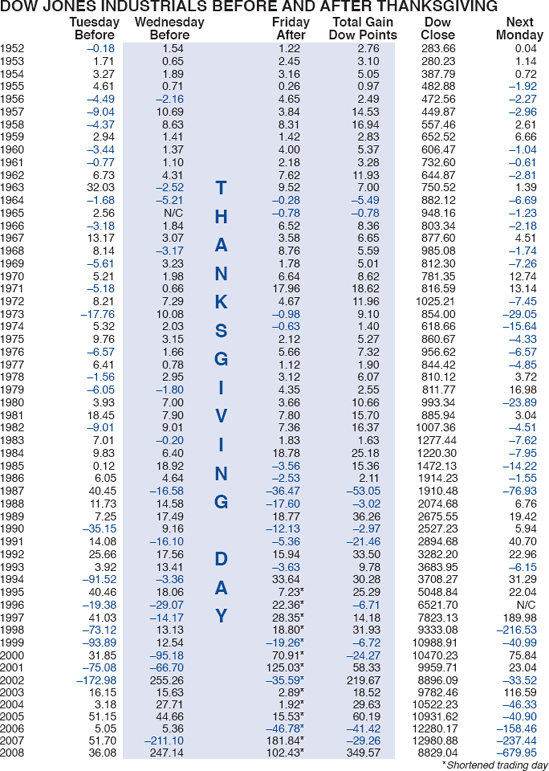
NOVEMBER

The time to buy is when blood is running in the streets.

Economics is a very difficult subject. I've compared it to trying to learn how to repair a car when the engine is running.

Investors operate with limited funds and limited intelligence, they don't need to know everything. As long as they understand something better than others, they have an edge.
Veterans' Day

Buy when you are scared to death; sell when are tickled to death.

The true mystery of the world is the visible, not the invisible.


Over the years we reported annually on the fascinating January Effect, showing that small-cap stocks handily outperformed large-cap stocks during January 40 out of 43 years between 1953 and 1995. Readers saw that "Cats and Dogs" on average quadrupled the returns of blue chips in this period. Then, the January Effect disappeared over the next four years.
Looking at the graph on page 106, comparing the Russell 1000 index of large-capitalization stocks to the Russell 2000 smaller-capitalization stocks, shows small-cap stocks beginning to outperform the blue chips in mid-December. Narrowing the comparison down to half-month segments was an inspiration and proved to be quite revealing, as you can see in the table below.

Small-cap strength in the last half of December became even more magnified after the 1987 market crash. Note the dramatic shift in gains in the last half of December during the 22-year period starting in 1987, versus the 30 years from 1979 to 2009. With all the beatendown small stocks being dumped for tax loss purposes, it generally pays to get a head start on the January Effect in mid-December. You don't have to wait until December either; the small-cap sector often begins to turn around toward the end of October.
NOVEMBER
Monday Before November Expiration, Dow Down 7 of Last 10 Dow Hit Big in 2008, Down 224 Points (2.6%)

If you torture the data long enough, it will confess to anything.

One of the more prolonged and extreme periods favoring large-cap stocks was 1994–1999. The tide turned in 2000. A cycle has begun of investors favoring small-cap stocks, which is likely to continue through the next several years.
Week Before Thanksgiving, Dow Up 13 of Last 16, 2003 −1.4%, 2004 −0.8%, 2008 −5.3%

[The Fed] is very smart, but [it] doesn't run the markets. In the end, the markets will run [the Fed]. The markets are bigger than any man or any group of men. The markets can even break a president...

Market risk tends to be poorly rewarded when market valuations are rich and interest rates are rising.
November Expiration Day, Dow Up 4 Straight and 6 of Last 7 Dow Surged in 2008, Up 494 Points (6.5%)

Your emotions are often a reverse indicator of what you ought to be doing.


Small-cap stocks tend to outperform big caps in January. Known as the "January Effect," the tendency is clearly revealed by the graph below. Thirty-one years of daily data for the Russell 2000 index of smaller companies are divided by the Russell 1000 index of largest companies, and then compressed into a single year to show an idealized yearly pattern. When the graph is descending, big blue chips are outperforming smaller companies; when the graph is rising, smaller companies are moving up faster than their larger brethren.
In a typical year, the smaller fry stay on the sidelines while the big boys are on the field. Then, around late October, small stocks begin to wake up, and in mid-December, they take off. Anticipated year-end dividends, payouts, and bonuses could be a factor. Other major moves are quite evident just before Labor Day—possibly because individual investors are back from vacations—and off the low points in late October and November. Small caps hold the lead through the beginning of June.

The bottom graph shows the actual ratio of the Russell 2000 divided by the Russell 1000 from 1979. Smaller companies had the upper hand for five years into 1983 as the last major bear trend wound to a close and the nascent bull market logged its first year. After falling behind for about eight years, they came back after the Persian Gulf War bottom in 1990, moving up until 1994, when big caps ruled the latter stages of the millennial bull. For six years the picture was bleak for small fry, as the blue chips and tech stocks moved to stratospheric PE ratios. Small caps spiked in late 1999 and early 2000 and reached a peak in early 2006, as the four-year-old bull entered its final year. Note how the small-cap advantage has waned at the outset of major bull moves and intensified during weak market times. Look for a clear move lower when the next major bull takes hold.

NOVEMBER
Trading Thanksgiving Market: Long into Weakness Prior Exit into Strength After (Page 102)

I've never been poor, only broke. Being poor is a frame of mind. Being broke is only a temporary situation.

Our philosophy here is identifying change, anticipating change. Change is what drives earnings growth, and if you identify the underlying change, you recognize the growth before the market, and the deceleration of that growth.

News on stocks is not important. How the stock reacts to it is important.
Thanksgiving (Market Closed)

Those who are of the opinion that money will do everything may very well be suspected to do everything for money.
(Shortened Trading Day)

Show me a good phone receptionist and I'll show you a good company.


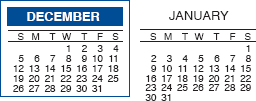

Market Probability Chart above is a graphic representation of the S&P 500 Recent Market Probability Calendar on page 124.
♦ #1 S&P (+1.6%) and #2 Dow (+1.7%) month since 1950 (page 44), #2 NASDAQ (1.9%) since 1971 ♦ 2002 worst December since 1931, down over 6% Dow and S&P, −9.7% on NASDAQ (pages 152, 155, and 157) ♦ "Free lunch" served on Wall Street before Christmas (page 110) ♦ Small caps start to outperform larger caps near middle of month (pages 104 and 106) ♦ "Santa Claus Rally" visible in graph above and on page 112 ♦ In 1998 was part of best fourth quarter since 1928 (page 167) ♦ Midterm election year Decembers since 1974 not stellar: Dow 0.2%, S&P 0.3%; NASDAQ 0.2%.

If Santa Claus should fail to call, Bears may come to Broad and Wall.
NOVEMBER/DECEMBER

Any human anywhere will blossom in a hundred unexpected talents and capacities simply by being given the opportunity to do so.

Don't worry about people stealing your ideas. If the ideas are any good, you'll have to ram them down people's throats.
First Trading Day in December, NASDAQ Up 9 of 10 from 1996–2005 Down Three Straight 2006–2008

When a company reports higher earnings for its first quarter (over its previous year's first quarter), chances are almost five to one it will also have increased earnings in its second quarter.
Chanukah

Good luck is what happens when preparation meets opportunity, bad luck is what happens when lack of preparation meets a challenge.

All you need to succeed is a yellow pad and a pencil.


December Almanac Investor Seasonalities: See Pages 114 and 116
Investors tend to get rid of their losers near year-end for tax purposes, often hammering these stocks down to bargain levels. Over the years, the Almanac has shown that NYSE stocks selling at their lows on December 15 will usually outperform the market by February 15 in the following year. Preferred stocks, closed-end funds, splits, and new issues are eliminated. When there are a huge number of new lows, stocks down the most are selected, even though there are usually good reasons why some stocks have been battered.
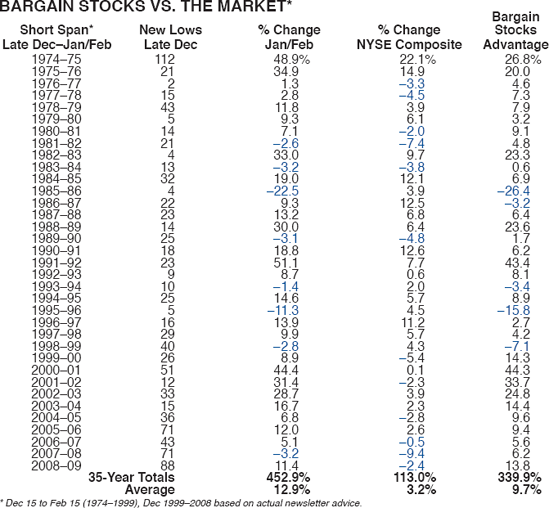
In response to changing market conditions, we tweaked the strategy the last 10 years adding selections from NASDAQ, AMEX, and the OTC Bulletin Board, and selling in mid-January some years. We e-mail the lists of stocks to our Almanac Investor newsletter subscribers.
We have come to the conclusion that the most prudent course of action is to compile our list from the stocks making new lows on the Friday before Christmas, capitalizing on the Santa Claus Rally (page 112). This also gives us the weekend to evaluate the issues in greater depth and weed out any glaringly problematic stocks. Subscribers will receive the list of stocks selected from the new lows made on December 21, 2009, via e-mail.
This "Free Lunch" strategy is only an extremely short-term strategy reserved for the nimblest traders. It has performed better after market corrections and when there are more new lows to choose from. The object is to buy bargain stocks near their 52-week lows and sell any quick, generous gains, as these issues can often be real dogs.
Examination of December trades by NYSE members through the years shows they tend to buy on balance during this month, contrary to other months. See more in our Almanac Investor Newsletters at stocktradersalmanac.com.
DECEMBER

The principles of successful stock speculation are based on the supposition that people will continue in the future to make the mistakes that they have made in the past.

Most people can stay excited for two or three months. A few people can stay excited for two or three years.
But a winner will stay excited for 20 to 30 years'or as long as it takes to win.
Small-Cap Strength Starts in Mid-December

640K ought to be enough for anybody.

I invest in people, not ideas; I want to see fire in the belly and intellect.

My best shorts come from research reports where there are recommendations to buy stocks on weakness; also, where a brokerage firm changes its recommendation from a buy to a hold.


Santa Claus tends to come to Wall Street nearly every year, bringing a short, sweet, respectable rally within the last five days of the year and the first two in January. This has been good for an average 1.6% gain since 1969 (1.5% since 1950). Santa's failure to show tends to precede bear markets, or times stocks could be purchased later in the year at much lower prices. We discovered this phenomenon in 1972.

The couplet above was certainly on the mark in 1999, as the period suffered a horrendous 4.0% loss. On January 14, 2000, the Dow started its 33-month 37.8% slide to the October 2002 midterm election year bottom. NASDAQ cracked eight weeks later, falling 37.3% in 10 weeks, eventually dropping 77.9% by October 2002. Saddam Hussein cancelled Christmas by invading Kuwait in 1990. Energy prices and Middle East terror woes may have grounded Santa in 2004. After an April low, 2005 registered one of the flattest years on record. In 2007, the third worst reading since 1950 was recorded, as subprime mortgages and their derivatives led to a full-blown financial crisis that sent the markets to 12-year lows over the next 15 months.
DECEMBER
Monday Before December Triple Witching Dow Down 3 of Last 4

Amongst democratic nations, each generation is a new people.

The commodity futures game is a money game'not a game involving the supply-demand of the actual commodity as commonly depicted.
December Triple Witching Week, Dow Up 22 of Last 25 2008 Broke 7-Year Bull Run

100% I did. 90% I will. 80% I can. 70% I think I can. 60% I might. 50% I think I might. 40% What is it? 30% I wish I could. 20% I don't know how. 10% I can't. 0% I won't.

He who wants to persuade should put his trust not in the right argument, but in the right word. The power of sound has always been greater than the power of sense.
December Triple Witching, Dow Up 18 of 27, with History of Huge Gains 1982 +2.2%, 1987 +2.6%, 1992 +1.4%, 1994 +1.1%, 2002 +1.8%, and 2007 +1.6%

The worst mistake investors make is taking their profits too soon, and their losses too long.


Sector seasonality was featured in the first 1968 Almanac. A Merrill Lynch study showed that buying seven sectors around September or October and selling in the first few months of 1954–1964 tripled the gains of holding them for 10 years. Over the past few years we have honed this strategy significantly and now devote a large portion of our time and resources to investing during seasonably favorable periods for different sectors with Exchange Traded Funds (ETFs).
Updated seasonalities appear in the table below. We specify whether the seasonality starts or finishes in the beginning third (B), middle third (M), or last third (E) of the month. These selected percentage plays are geared to take advantage of the bulk of seasonal sector bullishness.
By design, entry points are in advance of the major seasonal moves, providing traders ample opportunity to accumulate positions at favorable prices. Conversely, exit points have been selected to capture the majority of the advance, getting out ahead of any seasonal weakness.
From the sampling of the major seasonalities in the table below we created the Sector Index Seasonality Strategy Calendar on page 116. Note the concentration of bullish sector seasonalities during the Best Six Months, November to April.
As the ETF universe expands at breakneck speed, more seasonal investment options become available to Almanac Investors. Check our archives at stocktradersalmanac.com for updates and revisions to the strategy. We provide entry and exit points to Almanac Investor newsletter subscribers and detailed analysis in our monthly ETF Lab. Top 300 ETFs appear on pages 188–189.
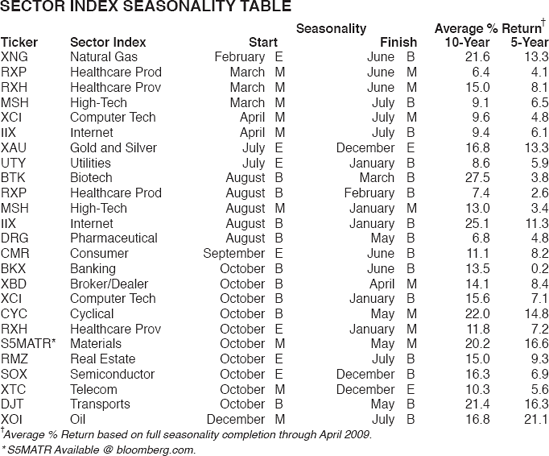
DECEMBER
The Only FREE LUNCH on Wall Street Is Served Almanac Investors E-mailed Alert Before the Open (Page 110)

There are three principal means of acquiring knowledge... observation of nature, reflection, and experimentation. Observation collects facts; reflection combines them; experimentation verifies the result of that combination.

The "canonical" market bottom typically features below-average valuations, falling interest rates, new lows in some major indices on diminished trading volume...and finally, a quick high-volume reversal in breadth....

Some people are so boring they make you waste an entire day in five minutes.
Last Trading Day Before Christmas Weak, Dow Down 4 of Last 7

Small business has been the first rung on the ladder upward for every minority group in the nation's history.
(Market Closed)

The pursuit of gain is the only way in which people can serve the needs of others whom they do not know.
Christmas Day



DECEMBER/JANUARY 2011
Watch for the Santa Claus Rally (Page 112)

Only those who will risk going too far can possibly find out how far one can go.

There is only one corner of the universe you can be certain of improving, and that's yourself.

We are all born originals; why is it so many die copies?

If all the economists in the world were laid end to end, they still wouldn't reach a conclusion.
Last Trading Day of the Year, 2008 Broke 8-Year NASDAQ Losing Streak NASDAQ Was Up 29 Years in a Row 1971–1999

Edison has done more toward abolishing poverty than all the reformers and statesmen.
New Year's Day



